Exercise Plan for Chronic Disease: A Case Study Report
VerifiedAdded on 2022/10/02
|25
|5256
|120
Report
AI Summary
This report presents a comprehensive exercise plan for a 57-year-old patient, Steven Brown, suffering from high cholesterol and coronary artery disease, which manifests as angina. The report begins with an introduction to physical fitness and its importance, followed by a detailed patient background, including vital signs and lifestyle. It then discusses the selected disease condition, elaborating on the causes, symptoms, and risk factors of coronary artery disease, including the impact of a sedentary lifestyle and high cholesterol. The report outlines various treatment methods, including lifestyle modifications like dietary changes (high-protein, low-fat, sodium-restricted diets) and medication. It also covers pre-exercise screening procedures, such as vital sign assessments, and exercise testing methods, including the use of an electronic treadmill. The report emphasizes the importance of monitoring the patient's condition throughout the exercise program. Desklib provides access to this and other past papers and assignments to help students with their studies.

Running head: EXERCISE PLAN
Exercise Plan
Name of the Student
Name of the University
Author Note
Exercise Plan
Name of the Student
Name of the University
Author Note
Secure Best Marks with AI Grader
Need help grading? Try our AI Grader for instant feedback on your assignments.
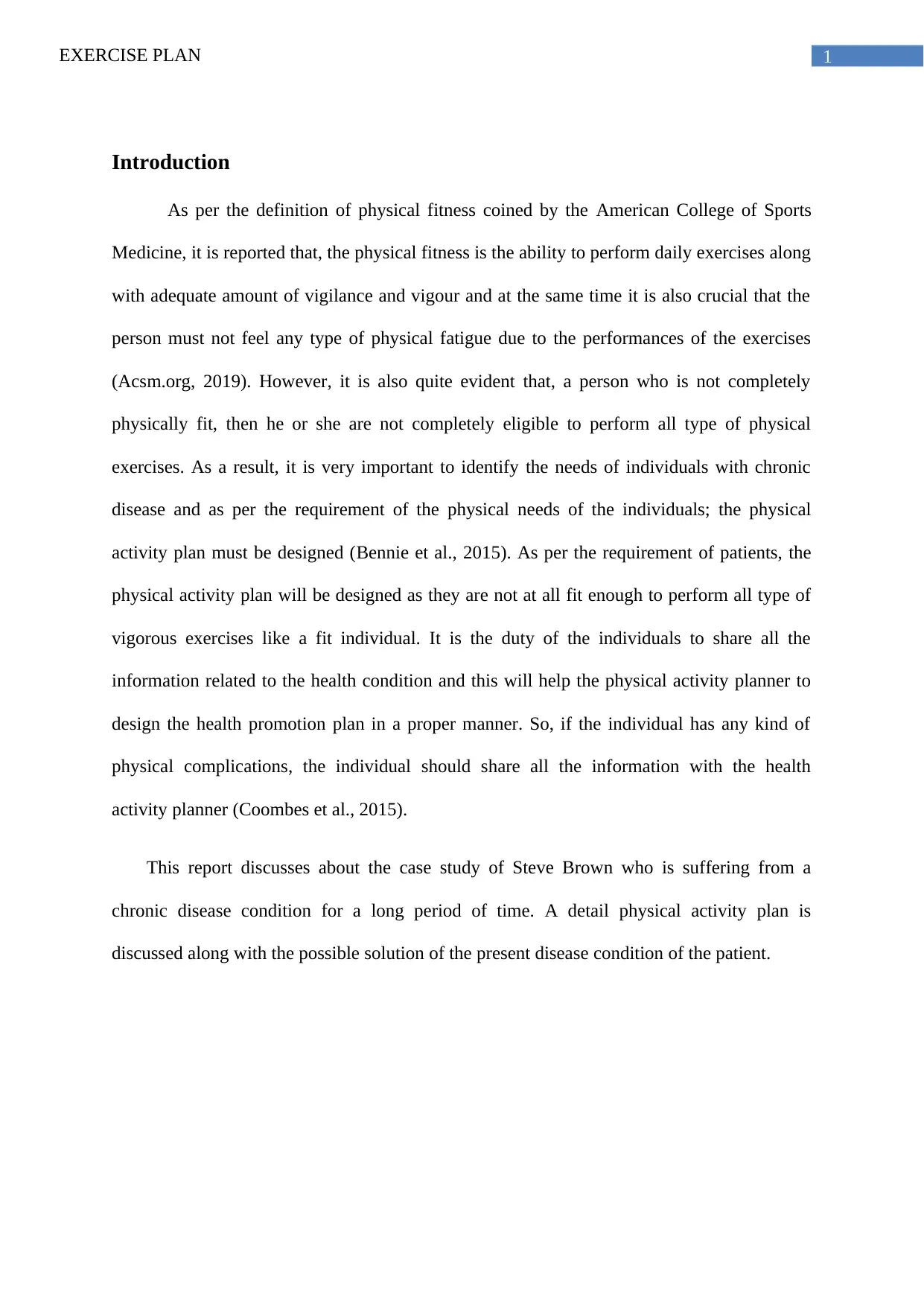
1EXERCISE PLAN
Introduction
As per the definition of physical fitness coined by the American College of Sports
Medicine, it is reported that, the physical fitness is the ability to perform daily exercises along
with adequate amount of vigilance and vigour and at the same time it is also crucial that the
person must not feel any type of physical fatigue due to the performances of the exercises
(Acsm.org, 2019). However, it is also quite evident that, a person who is not completely
physically fit, then he or she are not completely eligible to perform all type of physical
exercises. As a result, it is very important to identify the needs of individuals with chronic
disease and as per the requirement of the physical needs of the individuals; the physical
activity plan must be designed (Bennie et al., 2015). As per the requirement of patients, the
physical activity plan will be designed as they are not at all fit enough to perform all type of
vigorous exercises like a fit individual. It is the duty of the individuals to share all the
information related to the health condition and this will help the physical activity planner to
design the health promotion plan in a proper manner. So, if the individual has any kind of
physical complications, the individual should share all the information with the health
activity planner (Coombes et al., 2015).
This report discusses about the case study of Steve Brown who is suffering from a
chronic disease condition for a long period of time. A detail physical activity plan is
discussed along with the possible solution of the present disease condition of the patient.
Introduction
As per the definition of physical fitness coined by the American College of Sports
Medicine, it is reported that, the physical fitness is the ability to perform daily exercises along
with adequate amount of vigilance and vigour and at the same time it is also crucial that the
person must not feel any type of physical fatigue due to the performances of the exercises
(Acsm.org, 2019). However, it is also quite evident that, a person who is not completely
physically fit, then he or she are not completely eligible to perform all type of physical
exercises. As a result, it is very important to identify the needs of individuals with chronic
disease and as per the requirement of the physical needs of the individuals; the physical
activity plan must be designed (Bennie et al., 2015). As per the requirement of patients, the
physical activity plan will be designed as they are not at all fit enough to perform all type of
vigorous exercises like a fit individual. It is the duty of the individuals to share all the
information related to the health condition and this will help the physical activity planner to
design the health promotion plan in a proper manner. So, if the individual has any kind of
physical complications, the individual should share all the information with the health
activity planner (Coombes et al., 2015).
This report discusses about the case study of Steve Brown who is suffering from a
chronic disease condition for a long period of time. A detail physical activity plan is
discussed along with the possible solution of the present disease condition of the patient.

2EXERCISE PLAN
Patient Details
Background Information of Patient
Steven Brown is a 57 years old man who is suffering from high level of blood
cholesterol levels along with the coronary artery disease. The patient was experiencing
angina which defined by reduced blood flow to the heart (Lippi & Favaloro, 2019). In order
to enhance the physical activity condition of the patient, multiple physical activity plans and
exercises can be recommended for the patient. The patient has no history of previous health
related injuries and he is a former soccer player. On the vital sign assessment, it is observed
that, the patient has the high blood pressure level (almost 146/ 100mm hg). The heart rate of
the patient is reported as 86 beats/ min. Therefore, in this case study, the cardiac condition of
the patient must be considered during the development of the exercise plan of the patient.
Along with this, the age related condition of the patients should be considered during
developing the exercise plan. As the age of the patient is almost 57 year, hence, the
functionality of the cardiac muscles is also reduced. According to the study of McNamara et
al., (2017), it is reported that, with growing age, the tenacity and functionality of the cardiac
muscles are also reduced and so the working capacity of heart is also decreased. As a result,
the efficiency of performing physical activity of that particular individual is also deduced as
part of their growing age.
Name of the
Patient
Age Blood
Pressure
Heart rate Body
temperature
Lifestyle
Steven
Brown
57 146/100 mm
hg.
86 beats/min 36.4 degree
centigrade
Sedentary
Last year, the patient was also admitted to the hospital due to the problem of angina and from
that time onwards, the patient came to know about the high blood cholesterol level in his
body.
Patient Details
Background Information of Patient
Steven Brown is a 57 years old man who is suffering from high level of blood
cholesterol levels along with the coronary artery disease. The patient was experiencing
angina which defined by reduced blood flow to the heart (Lippi & Favaloro, 2019). In order
to enhance the physical activity condition of the patient, multiple physical activity plans and
exercises can be recommended for the patient. The patient has no history of previous health
related injuries and he is a former soccer player. On the vital sign assessment, it is observed
that, the patient has the high blood pressure level (almost 146/ 100mm hg). The heart rate of
the patient is reported as 86 beats/ min. Therefore, in this case study, the cardiac condition of
the patient must be considered during the development of the exercise plan of the patient.
Along with this, the age related condition of the patients should be considered during
developing the exercise plan. As the age of the patient is almost 57 year, hence, the
functionality of the cardiac muscles is also reduced. According to the study of McNamara et
al., (2017), it is reported that, with growing age, the tenacity and functionality of the cardiac
muscles are also reduced and so the working capacity of heart is also decreased. As a result,
the efficiency of performing physical activity of that particular individual is also deduced as
part of their growing age.
Name of the
Patient
Age Blood
Pressure
Heart rate Body
temperature
Lifestyle
Steven
Brown
57 146/100 mm
hg.
86 beats/min 36.4 degree
centigrade
Sedentary
Last year, the patient was also admitted to the hospital due to the problem of angina and from
that time onwards, the patient came to know about the high blood cholesterol level in his
body.
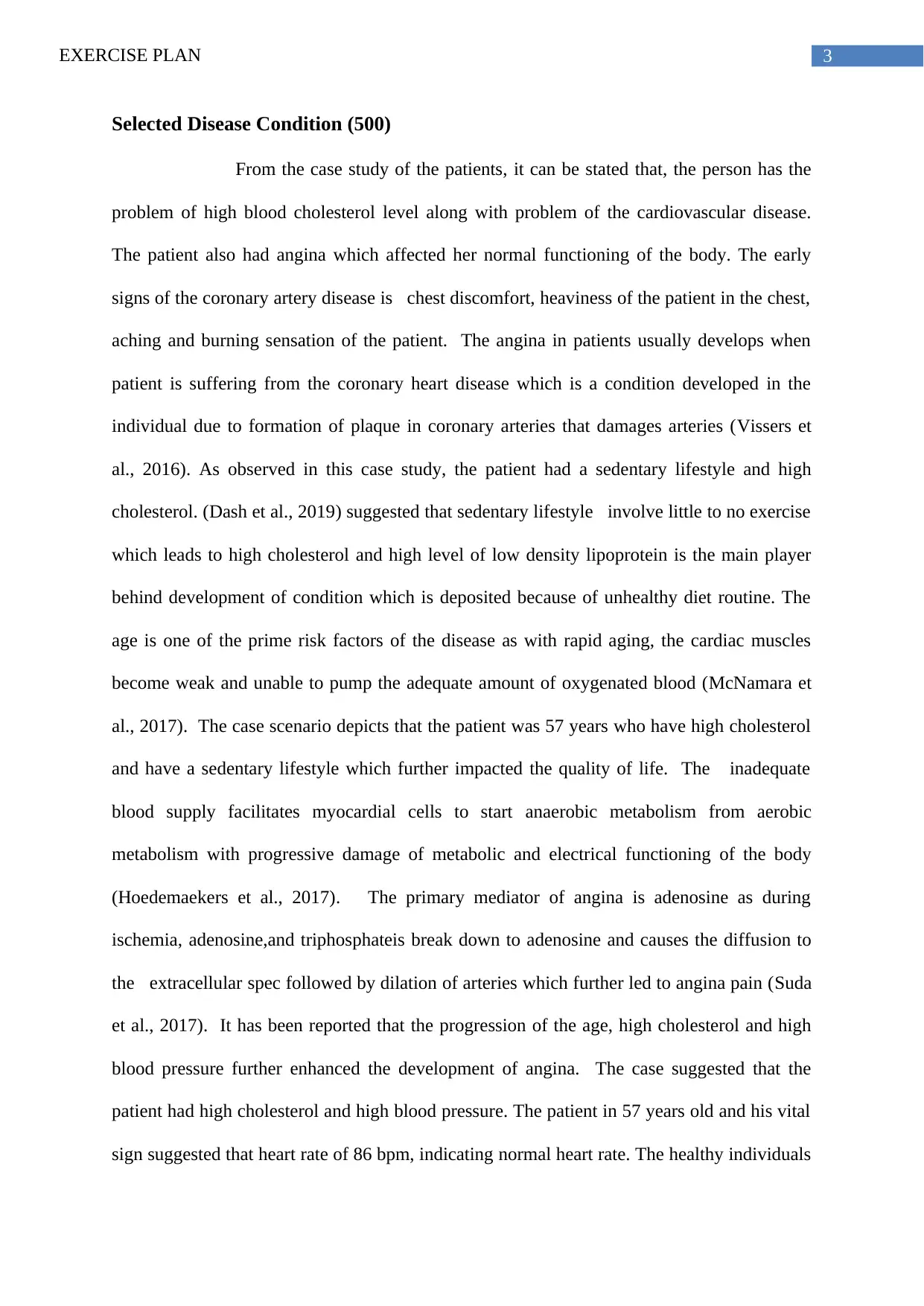
3EXERCISE PLAN
Selected Disease Condition (500)
From the case study of the patients, it can be stated that, the person has the
problem of high blood cholesterol level along with problem of the cardiovascular disease.
The patient also had angina which affected her normal functioning of the body. The early
signs of the coronary artery disease is chest discomfort, heaviness of the patient in the chest,
aching and burning sensation of the patient. The angina in patients usually develops when
patient is suffering from the coronary heart disease which is a condition developed in the
individual due to formation of plaque in coronary arteries that damages arteries (Vissers et
al., 2016). As observed in this case study, the patient had a sedentary lifestyle and high
cholesterol. (Dash et al., 2019) suggested that sedentary lifestyle involve little to no exercise
which leads to high cholesterol and high level of low density lipoprotein is the main player
behind development of condition which is deposited because of unhealthy diet routine. The
age is one of the prime risk factors of the disease as with rapid aging, the cardiac muscles
become weak and unable to pump the adequate amount of oxygenated blood (McNamara et
al., 2017). The case scenario depicts that the patient was 57 years who have high cholesterol
and have a sedentary lifestyle which further impacted the quality of life. The inadequate
blood supply facilitates myocardial cells to start anaerobic metabolism from aerobic
metabolism with progressive damage of metabolic and electrical functioning of the body
(Hoedemaekers et al., 2017). The primary mediator of angina is adenosine as during
ischemia, adenosine,and triphosphateis break down to adenosine and causes the diffusion to
the extracellular spec followed by dilation of arteries which further led to angina pain (Suda
et al., 2017). It has been reported that the progression of the age, high cholesterol and high
blood pressure further enhanced the development of angina. The case suggested that the
patient had high cholesterol and high blood pressure. The patient in 57 years old and his vital
sign suggested that heart rate of 86 bpm, indicating normal heart rate. The healthy individuals
Selected Disease Condition (500)
From the case study of the patients, it can be stated that, the person has the
problem of high blood cholesterol level along with problem of the cardiovascular disease.
The patient also had angina which affected her normal functioning of the body. The early
signs of the coronary artery disease is chest discomfort, heaviness of the patient in the chest,
aching and burning sensation of the patient. The angina in patients usually develops when
patient is suffering from the coronary heart disease which is a condition developed in the
individual due to formation of plaque in coronary arteries that damages arteries (Vissers et
al., 2016). As observed in this case study, the patient had a sedentary lifestyle and high
cholesterol. (Dash et al., 2019) suggested that sedentary lifestyle involve little to no exercise
which leads to high cholesterol and high level of low density lipoprotein is the main player
behind development of condition which is deposited because of unhealthy diet routine. The
age is one of the prime risk factors of the disease as with rapid aging, the cardiac muscles
become weak and unable to pump the adequate amount of oxygenated blood (McNamara et
al., 2017). The case scenario depicts that the patient was 57 years who have high cholesterol
and have a sedentary lifestyle which further impacted the quality of life. The inadequate
blood supply facilitates myocardial cells to start anaerobic metabolism from aerobic
metabolism with progressive damage of metabolic and electrical functioning of the body
(Hoedemaekers et al., 2017). The primary mediator of angina is adenosine as during
ischemia, adenosine,and triphosphateis break down to adenosine and causes the diffusion to
the extracellular spec followed by dilation of arteries which further led to angina pain (Suda
et al., 2017). It has been reported that the progression of the age, high cholesterol and high
blood pressure further enhanced the development of angina. The case suggested that the
patient had high cholesterol and high blood pressure. The patient in 57 years old and his vital
sign suggested that heart rate of 86 bpm, indicating normal heart rate. The healthy individuals
Secure Best Marks with AI Grader
Need help grading? Try our AI Grader for instant feedback on your assignments.
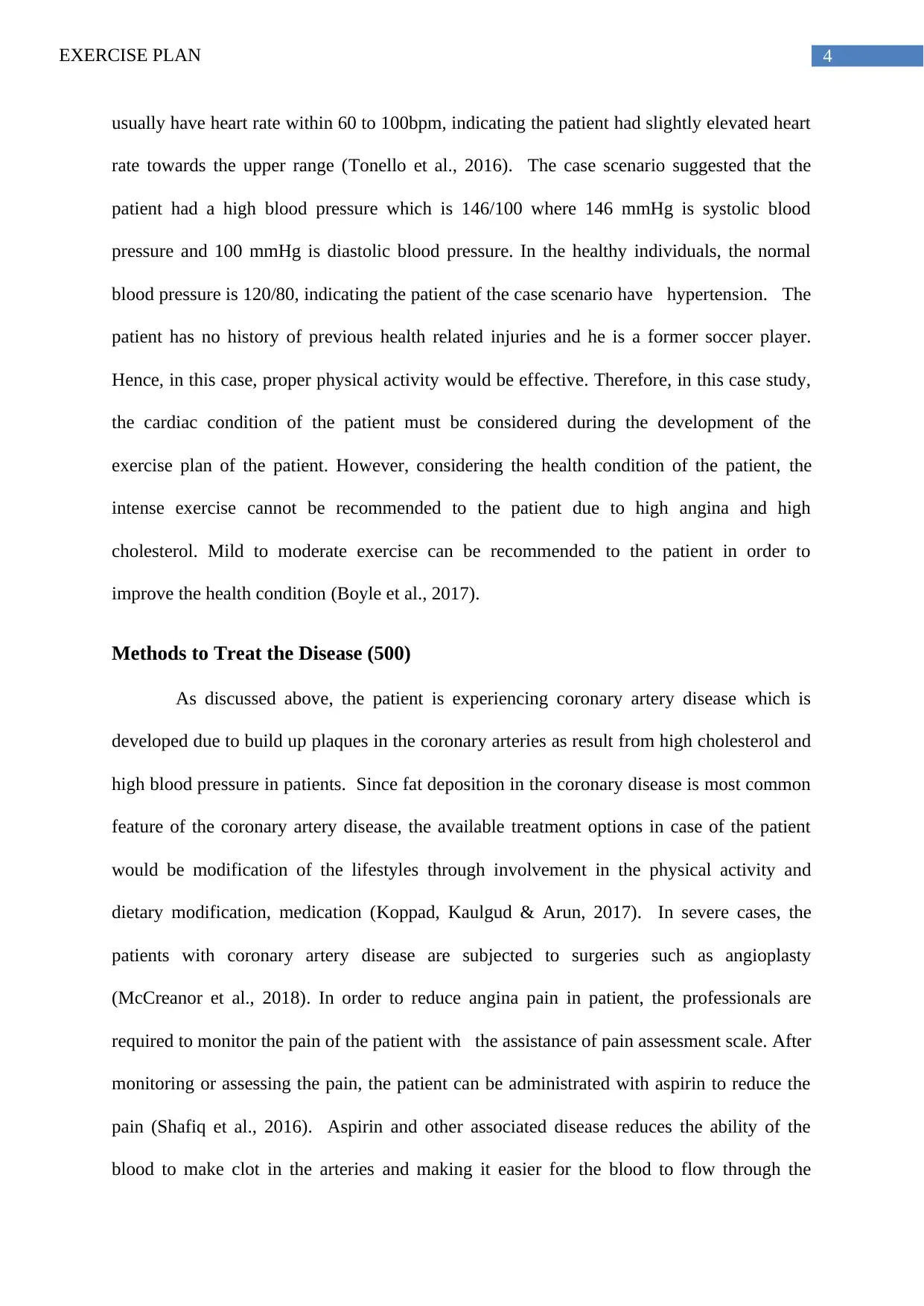
4EXERCISE PLAN
usually have heart rate within 60 to 100bpm, indicating the patient had slightly elevated heart
rate towards the upper range (Tonello et al., 2016). The case scenario suggested that the
patient had a high blood pressure which is 146/100 where 146 mmHg is systolic blood
pressure and 100 mmHg is diastolic blood pressure. In the healthy individuals, the normal
blood pressure is 120/80, indicating the patient of the case scenario have hypertension. The
patient has no history of previous health related injuries and he is a former soccer player.
Hence, in this case, proper physical activity would be effective. Therefore, in this case study,
the cardiac condition of the patient must be considered during the development of the
exercise plan of the patient. However, considering the health condition of the patient, the
intense exercise cannot be recommended to the patient due to high angina and high
cholesterol. Mild to moderate exercise can be recommended to the patient in order to
improve the health condition (Boyle et al., 2017).
Methods to Treat the Disease (500)
As discussed above, the patient is experiencing coronary artery disease which is
developed due to build up plaques in the coronary arteries as result from high cholesterol and
high blood pressure in patients. Since fat deposition in the coronary disease is most common
feature of the coronary artery disease, the available treatment options in case of the patient
would be modification of the lifestyles through involvement in the physical activity and
dietary modification, medication (Koppad, Kaulgud & Arun, 2017). In severe cases, the
patients with coronary artery disease are subjected to surgeries such as angioplasty
(McCreanor et al., 2018). In order to reduce angina pain in patient, the professionals are
required to monitor the pain of the patient with the assistance of pain assessment scale. After
monitoring or assessing the pain, the patient can be administrated with aspirin to reduce the
pain (Shafiq et al., 2016). Aspirin and other associated disease reduces the ability of the
blood to make clot in the arteries and making it easier for the blood to flow through the
usually have heart rate within 60 to 100bpm, indicating the patient had slightly elevated heart
rate towards the upper range (Tonello et al., 2016). The case scenario suggested that the
patient had a high blood pressure which is 146/100 where 146 mmHg is systolic blood
pressure and 100 mmHg is diastolic blood pressure. In the healthy individuals, the normal
blood pressure is 120/80, indicating the patient of the case scenario have hypertension. The
patient has no history of previous health related injuries and he is a former soccer player.
Hence, in this case, proper physical activity would be effective. Therefore, in this case study,
the cardiac condition of the patient must be considered during the development of the
exercise plan of the patient. However, considering the health condition of the patient, the
intense exercise cannot be recommended to the patient due to high angina and high
cholesterol. Mild to moderate exercise can be recommended to the patient in order to
improve the health condition (Boyle et al., 2017).
Methods to Treat the Disease (500)
As discussed above, the patient is experiencing coronary artery disease which is
developed due to build up plaques in the coronary arteries as result from high cholesterol and
high blood pressure in patients. Since fat deposition in the coronary disease is most common
feature of the coronary artery disease, the available treatment options in case of the patient
would be modification of the lifestyles through involvement in the physical activity and
dietary modification, medication (Koppad, Kaulgud & Arun, 2017). In severe cases, the
patients with coronary artery disease are subjected to surgeries such as angioplasty
(McCreanor et al., 2018). In order to reduce angina pain in patient, the professionals are
required to monitor the pain of the patient with the assistance of pain assessment scale. After
monitoring or assessing the pain, the patient can be administrated with aspirin to reduce the
pain (Shafiq et al., 2016). Aspirin and other associated disease reduces the ability of the
blood to make clot in the arteries and making it easier for the blood to flow through the
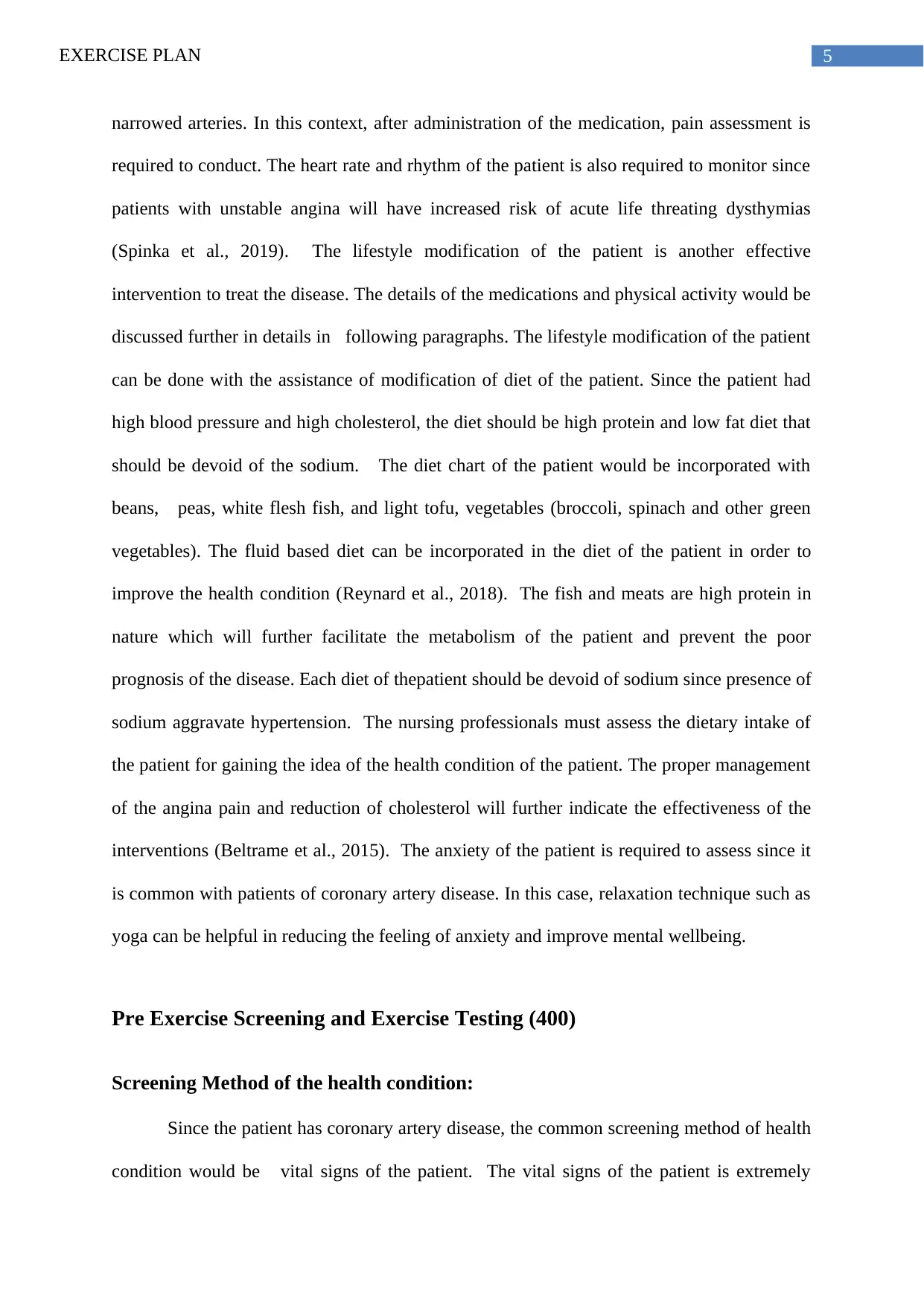
5EXERCISE PLAN
narrowed arteries. In this context, after administration of the medication, pain assessment is
required to conduct. The heart rate and rhythm of the patient is also required to monitor since
patients with unstable angina will have increased risk of acute life threating dysthymias
(Spinka et al., 2019). The lifestyle modification of the patient is another effective
intervention to treat the disease. The details of the medications and physical activity would be
discussed further in details in following paragraphs. The lifestyle modification of the patient
can be done with the assistance of modification of diet of the patient. Since the patient had
high blood pressure and high cholesterol, the diet should be high protein and low fat diet that
should be devoid of the sodium. The diet chart of the patient would be incorporated with
beans, peas, white flesh fish, and light tofu, vegetables (broccoli, spinach and other green
vegetables). The fluid based diet can be incorporated in the diet of the patient in order to
improve the health condition (Reynard et al., 2018). The fish and meats are high protein in
nature which will further facilitate the metabolism of the patient and prevent the poor
prognosis of the disease. Each diet of thepatient should be devoid of sodium since presence of
sodium aggravate hypertension. The nursing professionals must assess the dietary intake of
the patient for gaining the idea of the health condition of the patient. The proper management
of the angina pain and reduction of cholesterol will further indicate the effectiveness of the
interventions (Beltrame et al., 2015). The anxiety of the patient is required to assess since it
is common with patients of coronary artery disease. In this case, relaxation technique such as
yoga can be helpful in reducing the feeling of anxiety and improve mental wellbeing.
Pre Exercise Screening and Exercise Testing (400)
Screening Method of the health condition:
Since the patient has coronary artery disease, the common screening method of health
condition would be vital signs of the patient. The vital signs of the patient is extremely
narrowed arteries. In this context, after administration of the medication, pain assessment is
required to conduct. The heart rate and rhythm of the patient is also required to monitor since
patients with unstable angina will have increased risk of acute life threating dysthymias
(Spinka et al., 2019). The lifestyle modification of the patient is another effective
intervention to treat the disease. The details of the medications and physical activity would be
discussed further in details in following paragraphs. The lifestyle modification of the patient
can be done with the assistance of modification of diet of the patient. Since the patient had
high blood pressure and high cholesterol, the diet should be high protein and low fat diet that
should be devoid of the sodium. The diet chart of the patient would be incorporated with
beans, peas, white flesh fish, and light tofu, vegetables (broccoli, spinach and other green
vegetables). The fluid based diet can be incorporated in the diet of the patient in order to
improve the health condition (Reynard et al., 2018). The fish and meats are high protein in
nature which will further facilitate the metabolism of the patient and prevent the poor
prognosis of the disease. Each diet of thepatient should be devoid of sodium since presence of
sodium aggravate hypertension. The nursing professionals must assess the dietary intake of
the patient for gaining the idea of the health condition of the patient. The proper management
of the angina pain and reduction of cholesterol will further indicate the effectiveness of the
interventions (Beltrame et al., 2015). The anxiety of the patient is required to assess since it
is common with patients of coronary artery disease. In this case, relaxation technique such as
yoga can be helpful in reducing the feeling of anxiety and improve mental wellbeing.
Pre Exercise Screening and Exercise Testing (400)
Screening Method of the health condition:
Since the patient has coronary artery disease, the common screening method of health
condition would be vital signs of the patient. The vital signs of the patient is extremely
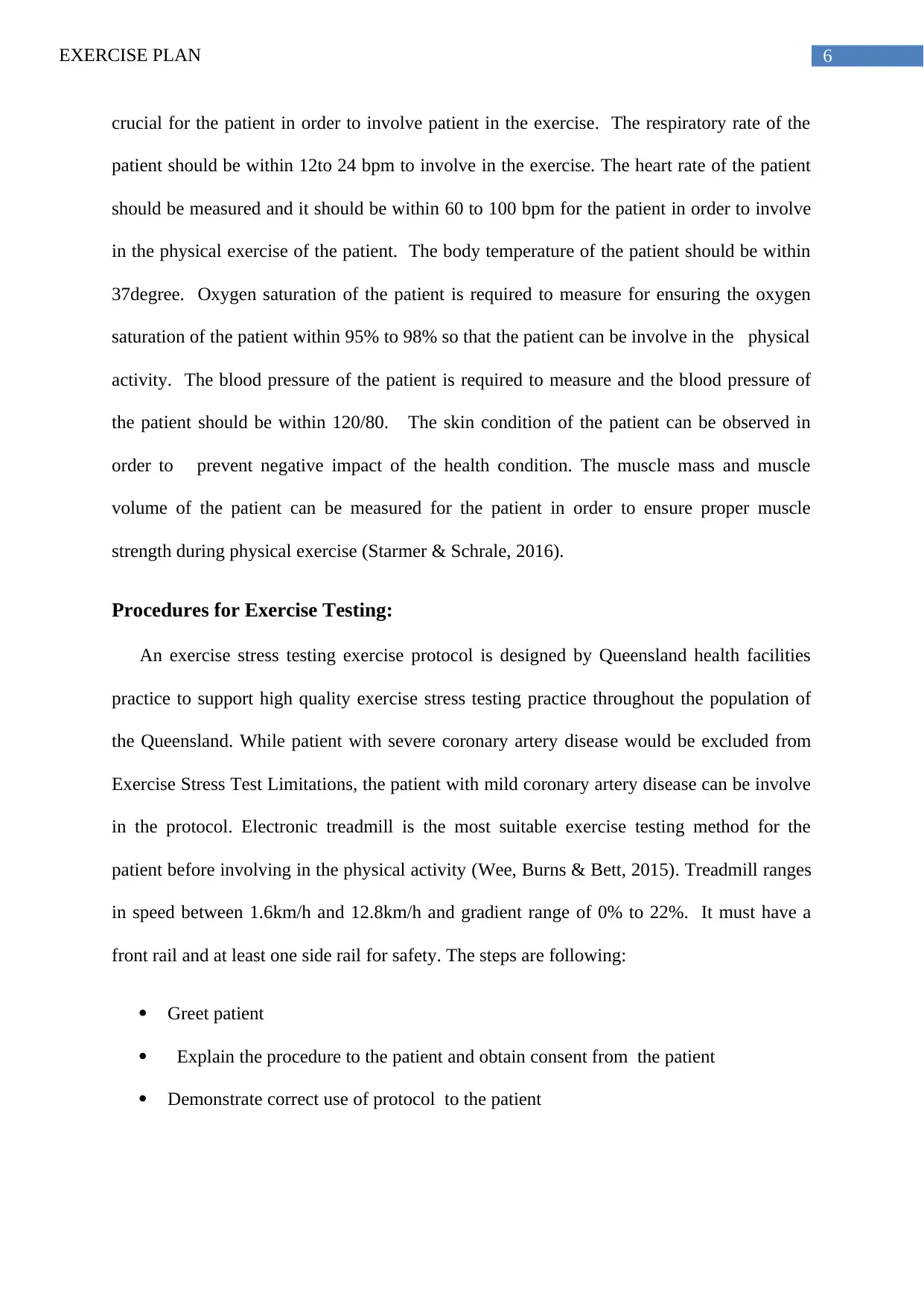
6EXERCISE PLAN
crucial for the patient in order to involve patient in the exercise. The respiratory rate of the
patient should be within 12to 24 bpm to involve in the exercise. The heart rate of the patient
should be measured and it should be within 60 to 100 bpm for the patient in order to involve
in the physical exercise of the patient. The body temperature of the patient should be within
37degree. Oxygen saturation of the patient is required to measure for ensuring the oxygen
saturation of the patient within 95% to 98% so that the patient can be involve in the physical
activity. The blood pressure of the patient is required to measure and the blood pressure of
the patient should be within 120/80. The skin condition of the patient can be observed in
order to prevent negative impact of the health condition. The muscle mass and muscle
volume of the patient can be measured for the patient in order to ensure proper muscle
strength during physical exercise (Starmer & Schrale, 2016).
Procedures for Exercise Testing:
An exercise stress testing exercise protocol is designed by Queensland health facilities
practice to support high quality exercise stress testing practice throughout the population of
the Queensland. While patient with severe coronary artery disease would be excluded from
Exercise Stress Test Limitations, the patient with mild coronary artery disease can be involve
in the protocol. Electronic treadmill is the most suitable exercise testing method for the
patient before involving in the physical activity (Wee, Burns & Bett, 2015). Treadmill ranges
in speed between 1.6km/h and 12.8km/h and gradient range of 0% to 22%. It must have a
front rail and at least one side rail for safety. The steps are following:
Greet patient
Explain the procedure to the patient and obtain consent from the patient
Demonstrate correct use of protocol to the patient
crucial for the patient in order to involve patient in the exercise. The respiratory rate of the
patient should be within 12to 24 bpm to involve in the exercise. The heart rate of the patient
should be measured and it should be within 60 to 100 bpm for the patient in order to involve
in the physical exercise of the patient. The body temperature of the patient should be within
37degree. Oxygen saturation of the patient is required to measure for ensuring the oxygen
saturation of the patient within 95% to 98% so that the patient can be involve in the physical
activity. The blood pressure of the patient is required to measure and the blood pressure of
the patient should be within 120/80. The skin condition of the patient can be observed in
order to prevent negative impact of the health condition. The muscle mass and muscle
volume of the patient can be measured for the patient in order to ensure proper muscle
strength during physical exercise (Starmer & Schrale, 2016).
Procedures for Exercise Testing:
An exercise stress testing exercise protocol is designed by Queensland health facilities
practice to support high quality exercise stress testing practice throughout the population of
the Queensland. While patient with severe coronary artery disease would be excluded from
Exercise Stress Test Limitations, the patient with mild coronary artery disease can be involve
in the protocol. Electronic treadmill is the most suitable exercise testing method for the
patient before involving in the physical activity (Wee, Burns & Bett, 2015). Treadmill ranges
in speed between 1.6km/h and 12.8km/h and gradient range of 0% to 22%. It must have a
front rail and at least one side rail for safety. The steps are following:
Greet patient
Explain the procedure to the patient and obtain consent from the patient
Demonstrate correct use of protocol to the patient
Paraphrase This Document
Need a fresh take? Get an instant paraphrase of this document with our AI Paraphraser
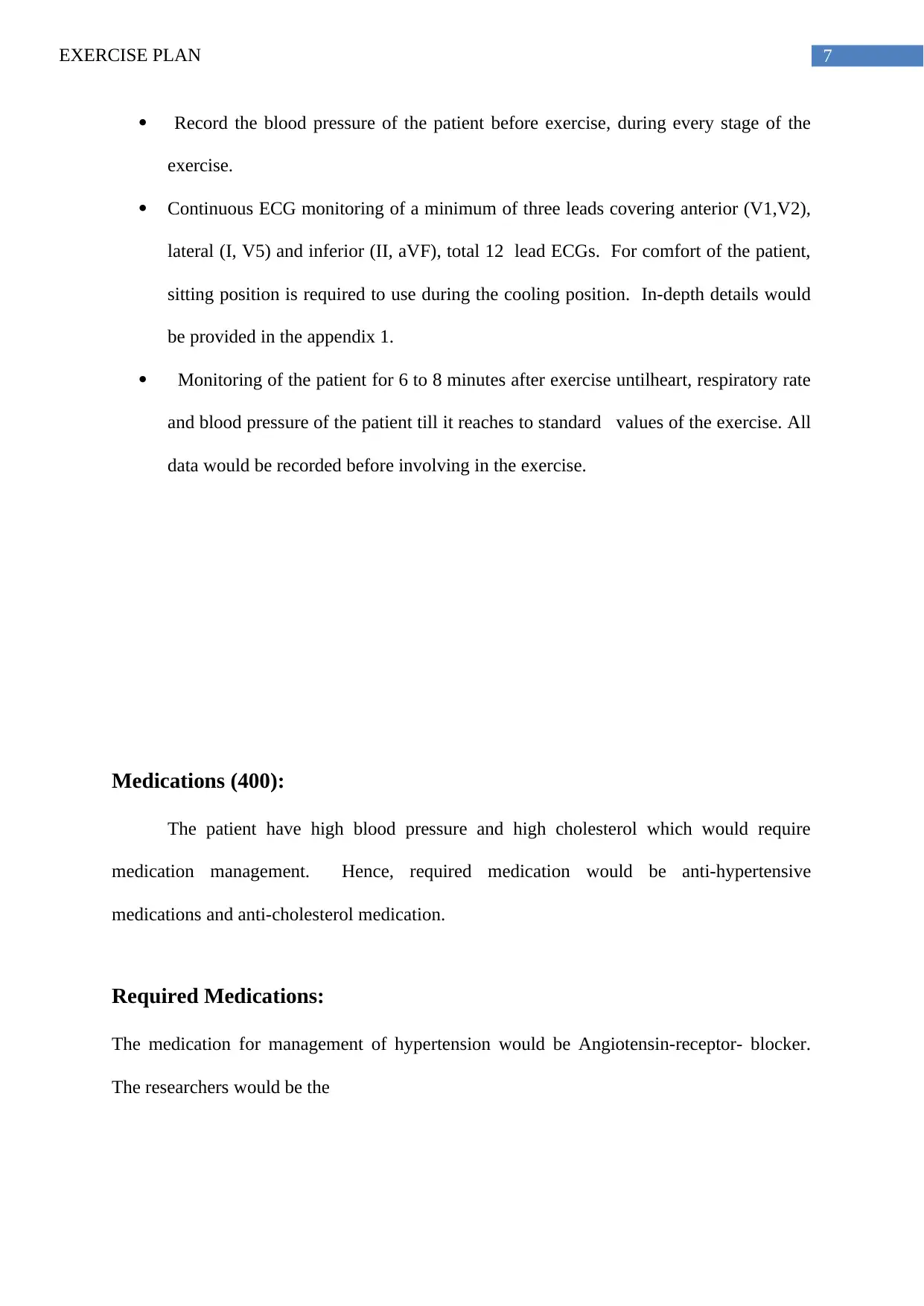
7EXERCISE PLAN
Record the blood pressure of the patient before exercise, during every stage of the
exercise.
Continuous ECG monitoring of a minimum of three leads covering anterior (V1,V2),
lateral (I, V5) and inferior (II, aVF), total 12 lead ECGs. For comfort of the patient,
sitting position is required to use during the cooling position. In-depth details would
be provided in the appendix 1.
Monitoring of the patient for 6 to 8 minutes after exercise untilheart, respiratory rate
and blood pressure of the patient till it reaches to standard values of the exercise. All
data would be recorded before involving in the exercise.
Medications (400):
The patient have high blood pressure and high cholesterol which would require
medication management. Hence, required medication would be anti-hypertensive
medications and anti-cholesterol medication.
Required Medications:
The medication for management of hypertension would be Angiotensin-receptor- blocker.
The researchers would be the
Record the blood pressure of the patient before exercise, during every stage of the
exercise.
Continuous ECG monitoring of a minimum of three leads covering anterior (V1,V2),
lateral (I, V5) and inferior (II, aVF), total 12 lead ECGs. For comfort of the patient,
sitting position is required to use during the cooling position. In-depth details would
be provided in the appendix 1.
Monitoring of the patient for 6 to 8 minutes after exercise untilheart, respiratory rate
and blood pressure of the patient till it reaches to standard values of the exercise. All
data would be recorded before involving in the exercise.
Medications (400):
The patient have high blood pressure and high cholesterol which would require
medication management. Hence, required medication would be anti-hypertensive
medications and anti-cholesterol medication.
Required Medications:
The medication for management of hypertension would be Angiotensin-receptor- blocker.
The researchers would be the
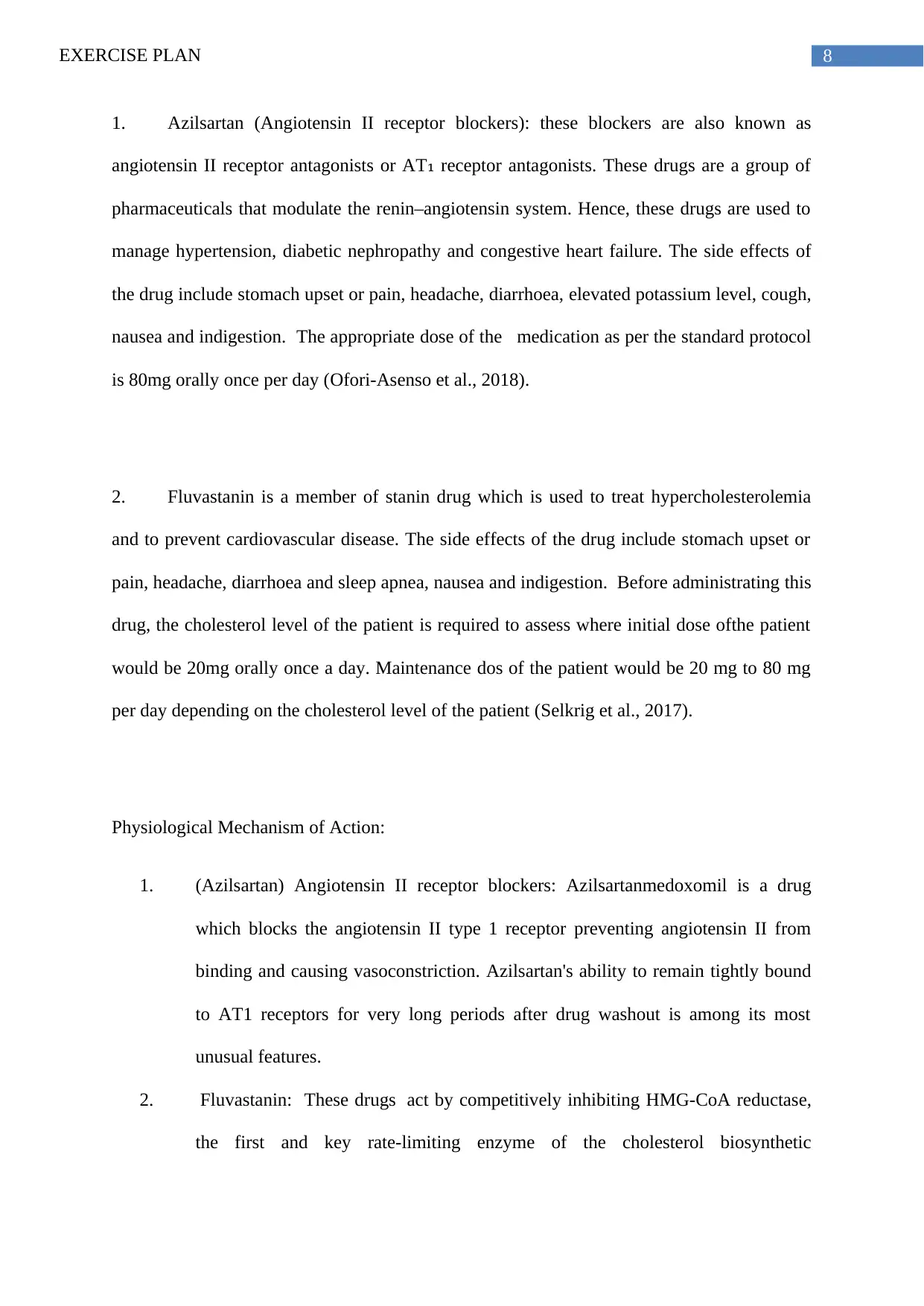
8EXERCISE PLAN
1. Azilsartan (Angiotensin II receptor blockers): these blockers are also known as
angiotensin II receptor antagonists or AT receptor antagonists. These drugs are a group of₁
pharmaceuticals that modulate the renin–angiotensin system. Hence, these drugs are used to
manage hypertension, diabetic nephropathy and congestive heart failure. The side effects of
the drug include stomach upset or pain, headache, diarrhoea, elevated potassium level, cough,
nausea and indigestion. The appropriate dose of the medication as per the standard protocol
is 80mg orally once per day (Ofori-Asenso et al., 2018).
2. Fluvastanin is a member of stanin drug which is used to treat hypercholesterolemia
and to prevent cardiovascular disease. The side effects of the drug include stomach upset or
pain, headache, diarrhoea and sleep apnea, nausea and indigestion. Before administrating this
drug, the cholesterol level of the patient is required to assess where initial dose ofthe patient
would be 20mg orally once a day. Maintenance dos of the patient would be 20 mg to 80 mg
per day depending on the cholesterol level of the patient (Selkrig et al., 2017).
Physiological Mechanism of Action:
1. (Azilsartan) Angiotensin II receptor blockers: Azilsartanmedoxomil is a drug
which blocks the angiotensin II type 1 receptor preventing angiotensin II from
binding and causing vasoconstriction. Azilsartan's ability to remain tightly bound
to AT1 receptors for very long periods after drug washout is among its most
unusual features.
2. Fluvastanin: These drugs act by competitively inhibiting HMG-CoA reductase,
the first and key rate-limiting enzyme of the cholesterol biosynthetic
1. Azilsartan (Angiotensin II receptor blockers): these blockers are also known as
angiotensin II receptor antagonists or AT receptor antagonists. These drugs are a group of₁
pharmaceuticals that modulate the renin–angiotensin system. Hence, these drugs are used to
manage hypertension, diabetic nephropathy and congestive heart failure. The side effects of
the drug include stomach upset or pain, headache, diarrhoea, elevated potassium level, cough,
nausea and indigestion. The appropriate dose of the medication as per the standard protocol
is 80mg orally once per day (Ofori-Asenso et al., 2018).
2. Fluvastanin is a member of stanin drug which is used to treat hypercholesterolemia
and to prevent cardiovascular disease. The side effects of the drug include stomach upset or
pain, headache, diarrhoea and sleep apnea, nausea and indigestion. Before administrating this
drug, the cholesterol level of the patient is required to assess where initial dose ofthe patient
would be 20mg orally once a day. Maintenance dos of the patient would be 20 mg to 80 mg
per day depending on the cholesterol level of the patient (Selkrig et al., 2017).
Physiological Mechanism of Action:
1. (Azilsartan) Angiotensin II receptor blockers: Azilsartanmedoxomil is a drug
which blocks the angiotensin II type 1 receptor preventing angiotensin II from
binding and causing vasoconstriction. Azilsartan's ability to remain tightly bound
to AT1 receptors for very long periods after drug washout is among its most
unusual features.
2. Fluvastanin: These drugs act by competitively inhibiting HMG-CoA reductase,
the first and key rate-limiting enzyme of the cholesterol biosynthetic
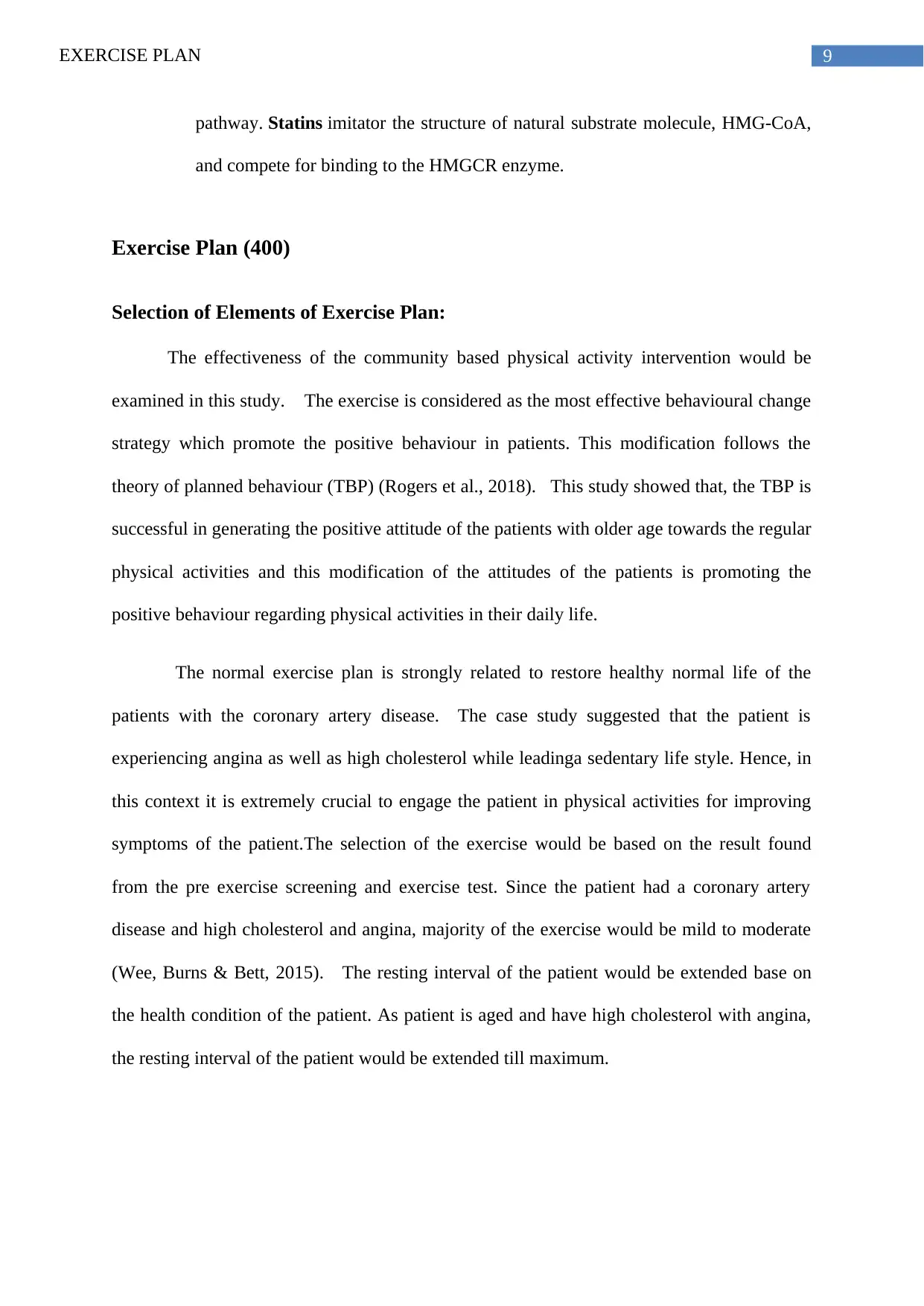
9EXERCISE PLAN
pathway. Statins imitator the structure of natural substrate molecule, HMG-CoA,
and compete for binding to the HMGCR enzyme.
Exercise Plan (400)
Selection of Elements of Exercise Plan:
The effectiveness of the community based physical activity intervention would be
examined in this study. The exercise is considered as the most effective behavioural change
strategy which promote the positive behaviour in patients. This modification follows the
theory of planned behaviour (TBP) (Rogers et al., 2018). This study showed that, the TBP is
successful in generating the positive attitude of the patients with older age towards the regular
physical activities and this modification of the attitudes of the patients is promoting the
positive behaviour regarding physical activities in their daily life.
The normal exercise plan is strongly related to restore healthy normal life of the
patients with the coronary artery disease. The case study suggested that the patient is
experiencing angina as well as high cholesterol while leadinga sedentary life style. Hence, in
this context it is extremely crucial to engage the patient in physical activities for improving
symptoms of the patient.The selection of the exercise would be based on the result found
from the pre exercise screening and exercise test. Since the patient had a coronary artery
disease and high cholesterol and angina, majority of the exercise would be mild to moderate
(Wee, Burns & Bett, 2015). The resting interval of the patient would be extended base on
the health condition of the patient. As patient is aged and have high cholesterol with angina,
the resting interval of the patient would be extended till maximum.
pathway. Statins imitator the structure of natural substrate molecule, HMG-CoA,
and compete for binding to the HMGCR enzyme.
Exercise Plan (400)
Selection of Elements of Exercise Plan:
The effectiveness of the community based physical activity intervention would be
examined in this study. The exercise is considered as the most effective behavioural change
strategy which promote the positive behaviour in patients. This modification follows the
theory of planned behaviour (TBP) (Rogers et al., 2018). This study showed that, the TBP is
successful in generating the positive attitude of the patients with older age towards the regular
physical activities and this modification of the attitudes of the patients is promoting the
positive behaviour regarding physical activities in their daily life.
The normal exercise plan is strongly related to restore healthy normal life of the
patients with the coronary artery disease. The case study suggested that the patient is
experiencing angina as well as high cholesterol while leadinga sedentary life style. Hence, in
this context it is extremely crucial to engage the patient in physical activities for improving
symptoms of the patient.The selection of the exercise would be based on the result found
from the pre exercise screening and exercise test. Since the patient had a coronary artery
disease and high cholesterol and angina, majority of the exercise would be mild to moderate
(Wee, Burns & Bett, 2015). The resting interval of the patient would be extended base on
the health condition of the patient. As patient is aged and have high cholesterol with angina,
the resting interval of the patient would be extended till maximum.
Secure Best Marks with AI Grader
Need help grading? Try our AI Grader for instant feedback on your assignments.
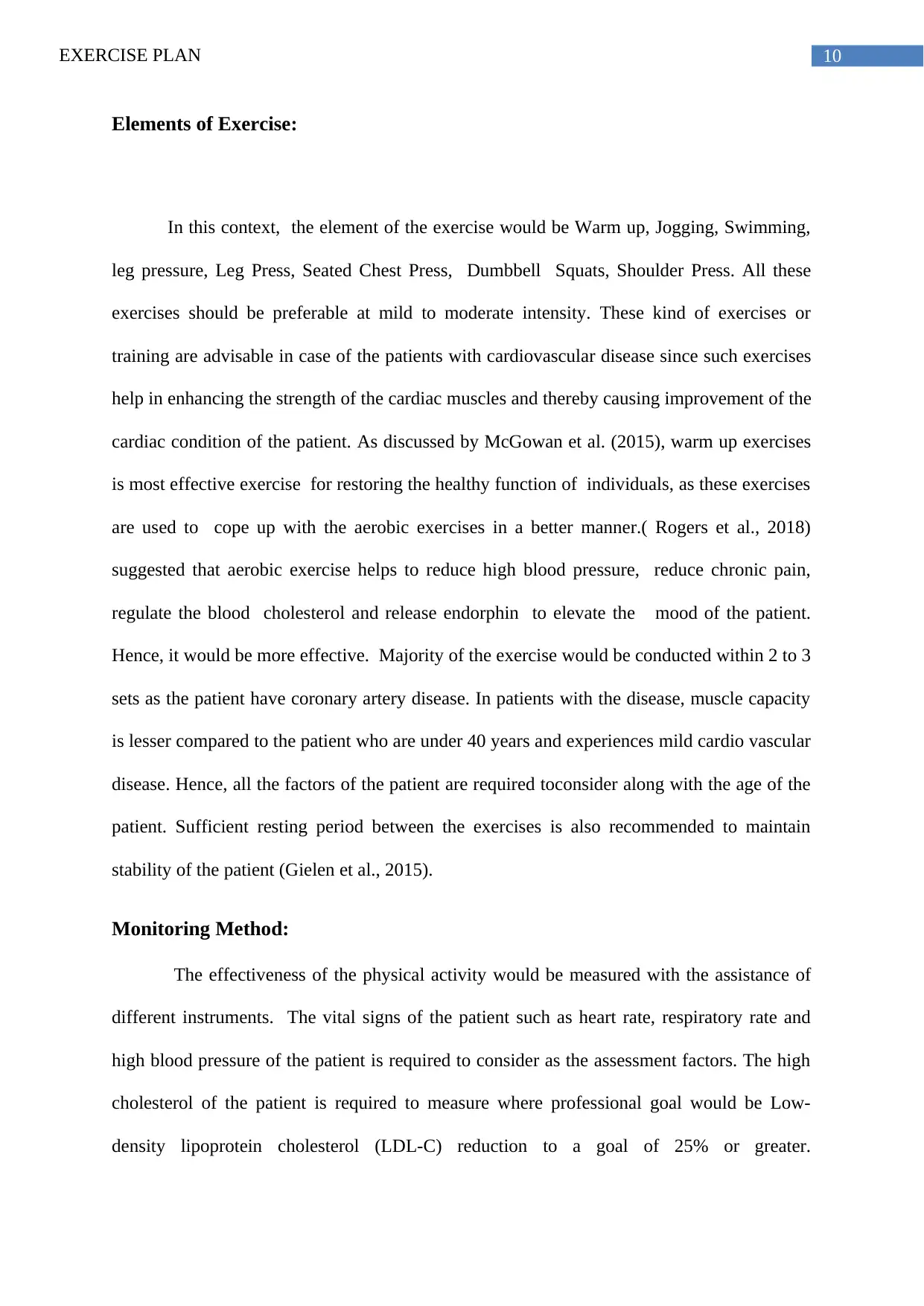
10EXERCISE PLAN
Elements of Exercise:
In this context, the element of the exercise would be Warm up, Jogging, Swimming,
leg pressure, Leg Press, Seated Chest Press, Dumbbell Squats, Shoulder Press. All these
exercises should be preferable at mild to moderate intensity. These kind of exercises or
training are advisable in case of the patients with cardiovascular disease since such exercises
help in enhancing the strength of the cardiac muscles and thereby causing improvement of the
cardiac condition of the patient. As discussed by McGowan et al. (2015), warm up exercises
is most effective exercise for restoring the healthy function of individuals, as these exercises
are used to cope up with the aerobic exercises in a better manner.( Rogers et al., 2018)
suggested that aerobic exercise helps to reduce high blood pressure, reduce chronic pain,
regulate the blood cholesterol and release endorphin to elevate the mood of the patient.
Hence, it would be more effective. Majority of the exercise would be conducted within 2 to 3
sets as the patient have coronary artery disease. In patients with the disease, muscle capacity
is lesser compared to the patient who are under 40 years and experiences mild cardio vascular
disease. Hence, all the factors of the patient are required toconsider along with the age of the
patient. Sufficient resting period between the exercises is also recommended to maintain
stability of the patient (Gielen et al., 2015).
Monitoring Method:
The effectiveness of the physical activity would be measured with the assistance of
different instruments. The vital signs of the patient such as heart rate, respiratory rate and
high blood pressure of the patient is required to consider as the assessment factors. The high
cholesterol of the patient is required to measure where professional goal would be Low-
density lipoprotein cholesterol (LDL-C) reduction to a goal of 25% or greater.
Elements of Exercise:
In this context, the element of the exercise would be Warm up, Jogging, Swimming,
leg pressure, Leg Press, Seated Chest Press, Dumbbell Squats, Shoulder Press. All these
exercises should be preferable at mild to moderate intensity. These kind of exercises or
training are advisable in case of the patients with cardiovascular disease since such exercises
help in enhancing the strength of the cardiac muscles and thereby causing improvement of the
cardiac condition of the patient. As discussed by McGowan et al. (2015), warm up exercises
is most effective exercise for restoring the healthy function of individuals, as these exercises
are used to cope up with the aerobic exercises in a better manner.( Rogers et al., 2018)
suggested that aerobic exercise helps to reduce high blood pressure, reduce chronic pain,
regulate the blood cholesterol and release endorphin to elevate the mood of the patient.
Hence, it would be more effective. Majority of the exercise would be conducted within 2 to 3
sets as the patient have coronary artery disease. In patients with the disease, muscle capacity
is lesser compared to the patient who are under 40 years and experiences mild cardio vascular
disease. Hence, all the factors of the patient are required toconsider along with the age of the
patient. Sufficient resting period between the exercises is also recommended to maintain
stability of the patient (Gielen et al., 2015).
Monitoring Method:
The effectiveness of the physical activity would be measured with the assistance of
different instruments. The vital signs of the patient such as heart rate, respiratory rate and
high blood pressure of the patient is required to consider as the assessment factors. The high
cholesterol of the patient is required to measure where professional goal would be Low-
density lipoprotein cholesterol (LDL-C) reduction to a goal of 25% or greater.
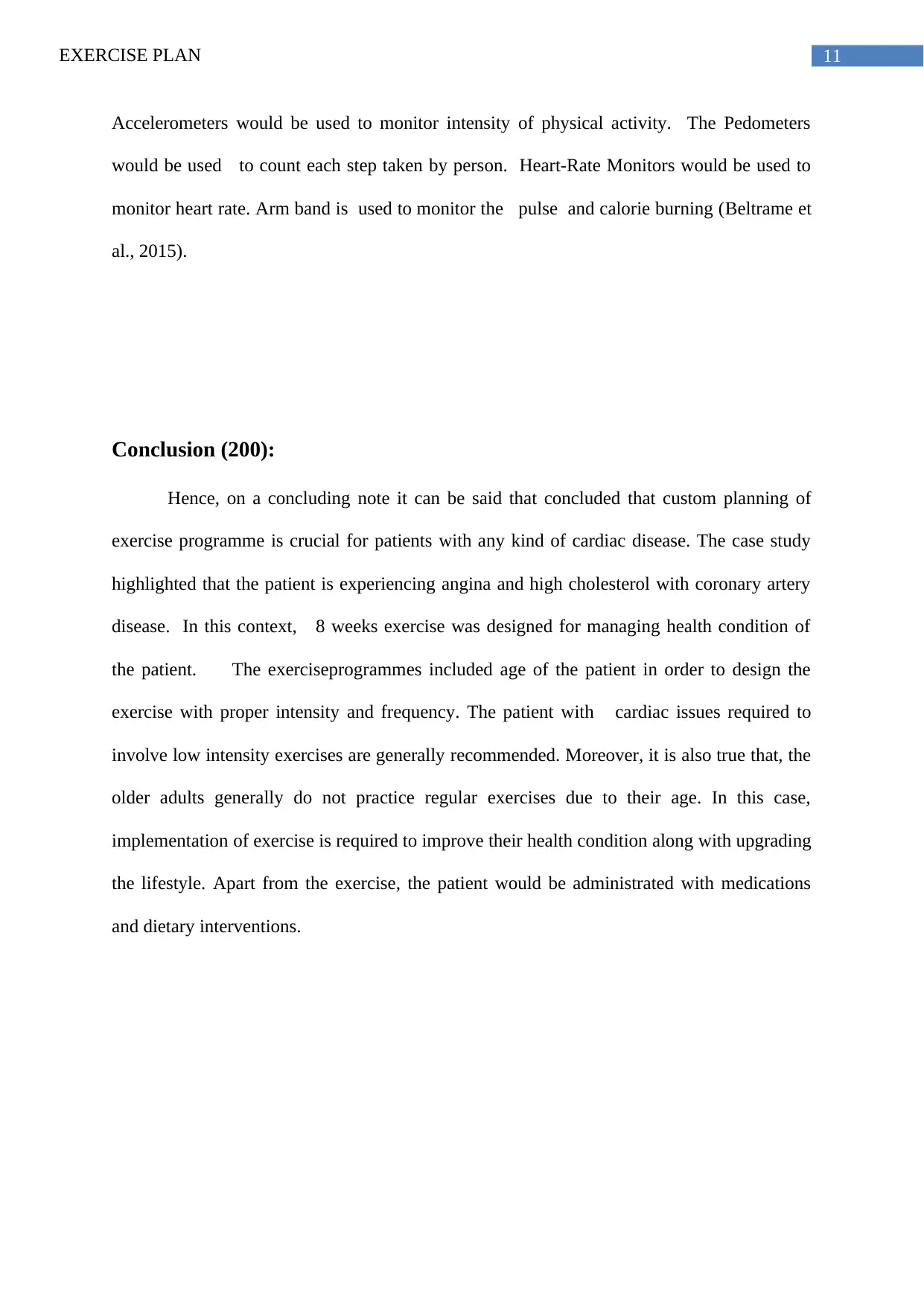
11EXERCISE PLAN
Accelerometers would be used to monitor intensity of physical activity. The Pedometers
would be used to count each step taken by person. Heart-Rate Monitors would be used to
monitor heart rate. Arm band is used to monitor the pulse and calorie burning (Beltrame et
al., 2015).
Conclusion (200):
Hence, on a concluding note it can be said that concluded that custom planning of
exercise programme is crucial for patients with any kind of cardiac disease. The case study
highlighted that the patient is experiencing angina and high cholesterol with coronary artery
disease. In this context, 8 weeks exercise was designed for managing health condition of
the patient. The exerciseprogrammes included age of the patient in order to design the
exercise with proper intensity and frequency. The patient with cardiac issues required to
involve low intensity exercises are generally recommended. Moreover, it is also true that, the
older adults generally do not practice regular exercises due to their age. In this case,
implementation of exercise is required to improve their health condition along with upgrading
the lifestyle. Apart from the exercise, the patient would be administrated with medications
and dietary interventions.
Accelerometers would be used to monitor intensity of physical activity. The Pedometers
would be used to count each step taken by person. Heart-Rate Monitors would be used to
monitor heart rate. Arm band is used to monitor the pulse and calorie burning (Beltrame et
al., 2015).
Conclusion (200):
Hence, on a concluding note it can be said that concluded that custom planning of
exercise programme is crucial for patients with any kind of cardiac disease. The case study
highlighted that the patient is experiencing angina and high cholesterol with coronary artery
disease. In this context, 8 weeks exercise was designed for managing health condition of
the patient. The exerciseprogrammes included age of the patient in order to design the
exercise with proper intensity and frequency. The patient with cardiac issues required to
involve low intensity exercises are generally recommended. Moreover, it is also true that, the
older adults generally do not practice regular exercises due to their age. In this case,
implementation of exercise is required to improve their health condition along with upgrading
the lifestyle. Apart from the exercise, the patient would be administrated with medications
and dietary interventions.

12EXERCISE PLAN
Paraphrase This Document
Need a fresh take? Get an instant paraphrase of this document with our AI Paraphraser
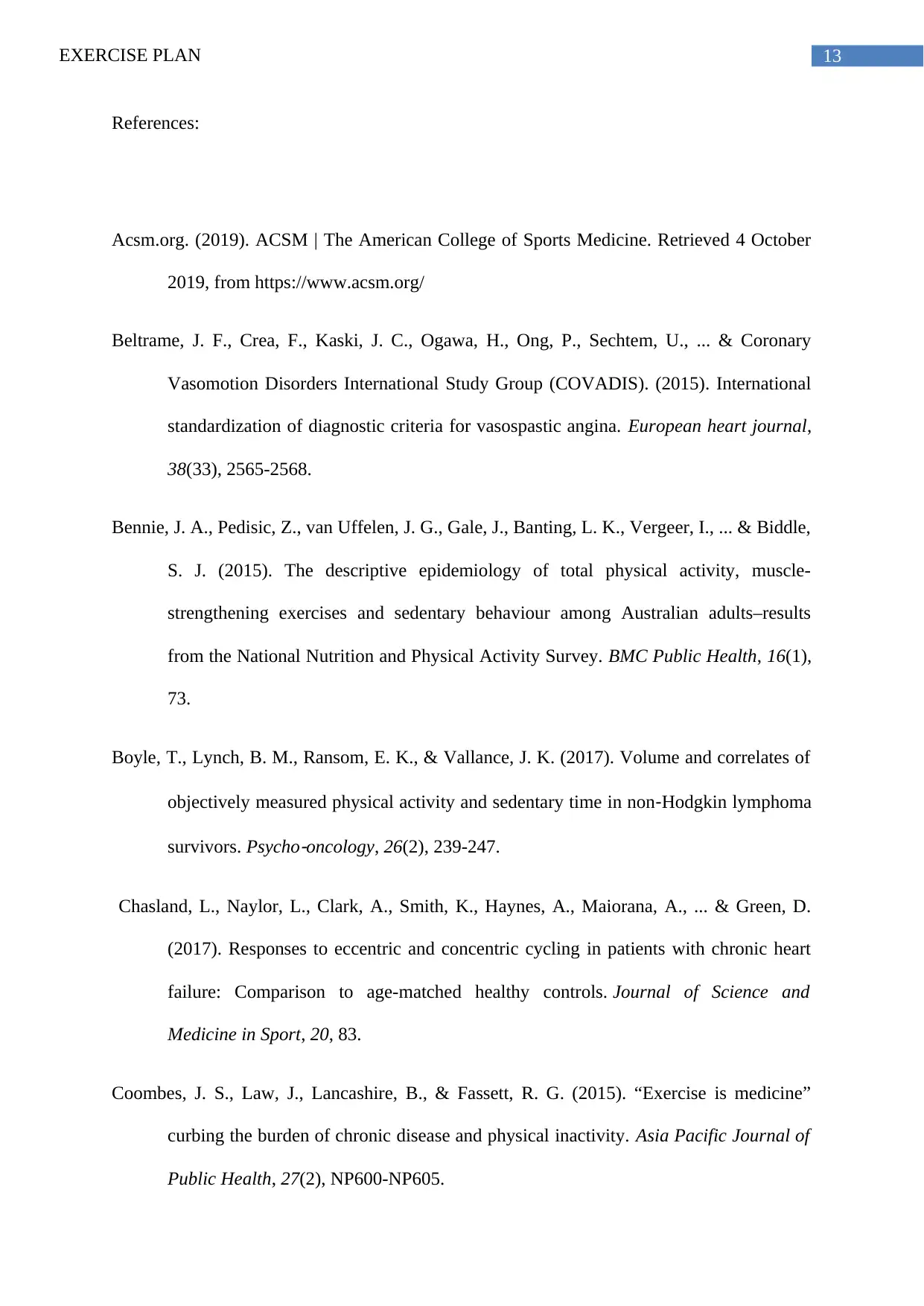
13EXERCISE PLAN
References:
Acsm.org. (2019). ACSM | The American College of Sports Medicine. Retrieved 4 October
2019, from https://www.acsm.org/
Beltrame, J. F., Crea, F., Kaski, J. C., Ogawa, H., Ong, P., Sechtem, U., ... & Coronary
Vasomotion Disorders International Study Group (COVADIS). (2015). International
standardization of diagnostic criteria for vasospastic angina. European heart journal,
38(33), 2565-2568.
Bennie, J. A., Pedisic, Z., van Uffelen, J. G., Gale, J., Banting, L. K., Vergeer, I., ... & Biddle,
S. J. (2015). The descriptive epidemiology of total physical activity, muscle-
strengthening exercises and sedentary behaviour among Australian adults–results
from the National Nutrition and Physical Activity Survey. BMC Public Health, 16(1),
73.
Boyle, T., Lynch, B. M., Ransom, E. K., & Vallance, J. K. (2017). Volume and correlates of
objectively measured physical activity and sedentary time in non‐Hodgkin lymphoma
survivors. Psycho
‐oncology, 26(2), 239-247.
Chasland, L., Naylor, L., Clark, A., Smith, K., Haynes, A., Maiorana, A., ... & Green, D.
(2017). Responses to eccentric and concentric cycling in patients with chronic heart
failure: Comparison to age-matched healthy controls. Journal of Science and
Medicine in Sport, 20, 83.
Coombes, J. S., Law, J., Lancashire, B., & Fassett, R. G. (2015). “Exercise is medicine”
curbing the burden of chronic disease and physical inactivity. Asia Pacific Journal of
Public Health, 27(2), NP600-NP605.
References:
Acsm.org. (2019). ACSM | The American College of Sports Medicine. Retrieved 4 October
2019, from https://www.acsm.org/
Beltrame, J. F., Crea, F., Kaski, J. C., Ogawa, H., Ong, P., Sechtem, U., ... & Coronary
Vasomotion Disorders International Study Group (COVADIS). (2015). International
standardization of diagnostic criteria for vasospastic angina. European heart journal,
38(33), 2565-2568.
Bennie, J. A., Pedisic, Z., van Uffelen, J. G., Gale, J., Banting, L. K., Vergeer, I., ... & Biddle,
S. J. (2015). The descriptive epidemiology of total physical activity, muscle-
strengthening exercises and sedentary behaviour among Australian adults–results
from the National Nutrition and Physical Activity Survey. BMC Public Health, 16(1),
73.
Boyle, T., Lynch, B. M., Ransom, E. K., & Vallance, J. K. (2017). Volume and correlates of
objectively measured physical activity and sedentary time in non‐Hodgkin lymphoma
survivors. Psycho
‐oncology, 26(2), 239-247.
Chasland, L., Naylor, L., Clark, A., Smith, K., Haynes, A., Maiorana, A., ... & Green, D.
(2017). Responses to eccentric and concentric cycling in patients with chronic heart
failure: Comparison to age-matched healthy controls. Journal of Science and
Medicine in Sport, 20, 83.
Coombes, J. S., Law, J., Lancashire, B., & Fassett, R. G. (2015). “Exercise is medicine”
curbing the burden of chronic disease and physical inactivity. Asia Pacific Journal of
Public Health, 27(2), NP600-NP605.
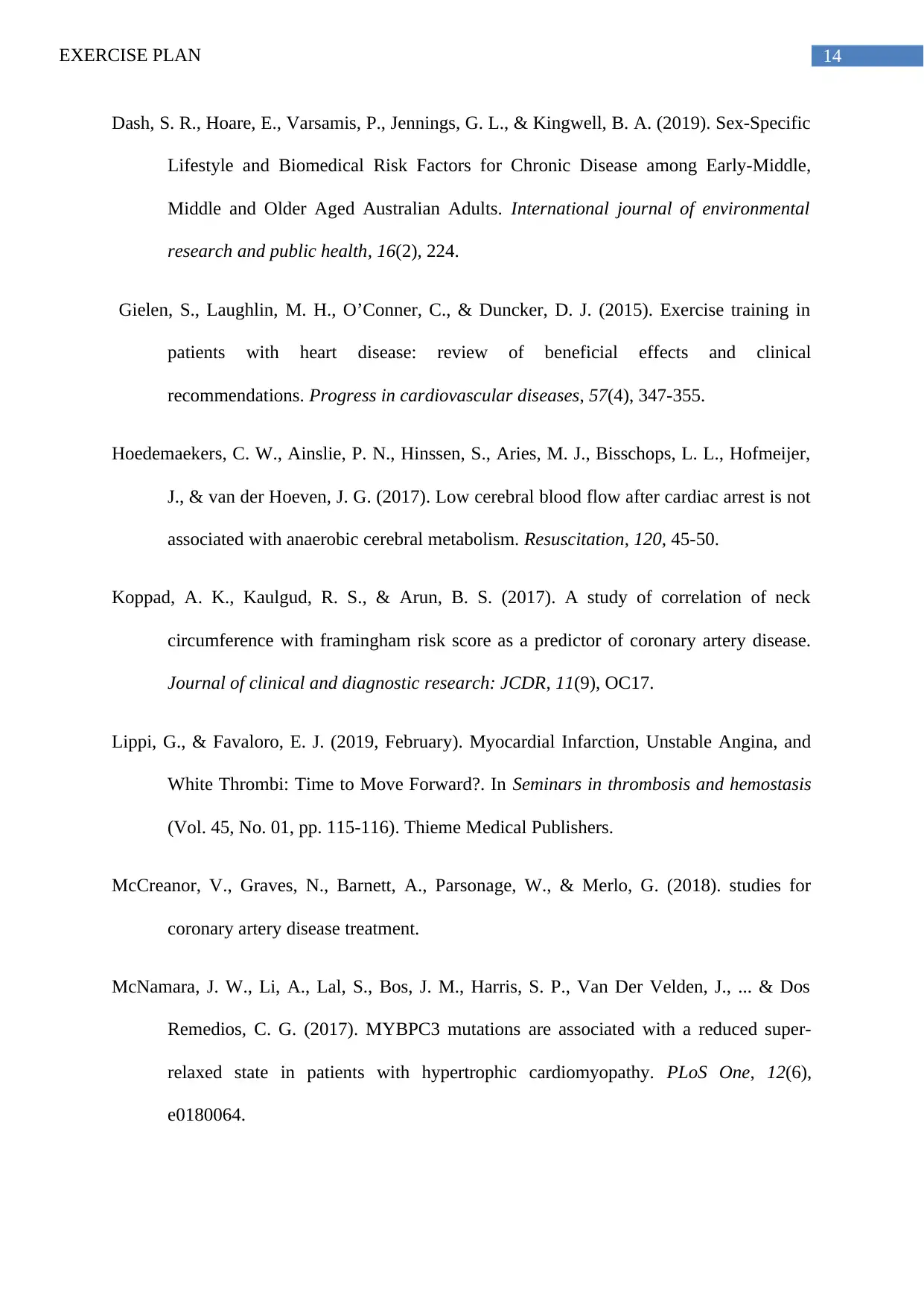
14EXERCISE PLAN
Dash, S. R., Hoare, E., Varsamis, P., Jennings, G. L., & Kingwell, B. A. (2019). Sex-Specific
Lifestyle and Biomedical Risk Factors for Chronic Disease among Early-Middle,
Middle and Older Aged Australian Adults. International journal of environmental
research and public health, 16(2), 224.
Gielen, S., Laughlin, M. H., O’Conner, C., & Duncker, D. J. (2015). Exercise training in
patients with heart disease: review of beneficial effects and clinical
recommendations. Progress in cardiovascular diseases, 57(4), 347-355.
Hoedemaekers, C. W., Ainslie, P. N., Hinssen, S., Aries, M. J., Bisschops, L. L., Hofmeijer,
J., & van der Hoeven, J. G. (2017). Low cerebral blood flow after cardiac arrest is not
associated with anaerobic cerebral metabolism. Resuscitation, 120, 45-50.
Koppad, A. K., Kaulgud, R. S., & Arun, B. S. (2017). A study of correlation of neck
circumference with framingham risk score as a predictor of coronary artery disease.
Journal of clinical and diagnostic research: JCDR, 11(9), OC17.
Lippi, G., & Favaloro, E. J. (2019, February). Myocardial Infarction, Unstable Angina, and
White Thrombi: Time to Move Forward?. In Seminars in thrombosis and hemostasis
(Vol. 45, No. 01, pp. 115-116). Thieme Medical Publishers.
McCreanor, V., Graves, N., Barnett, A., Parsonage, W., & Merlo, G. (2018). studies for
coronary artery disease treatment.
McNamara, J. W., Li, A., Lal, S., Bos, J. M., Harris, S. P., Van Der Velden, J., ... & Dos
Remedios, C. G. (2017). MYBPC3 mutations are associated with a reduced super-
relaxed state in patients with hypertrophic cardiomyopathy. PLoS One, 12(6),
e0180064.
Dash, S. R., Hoare, E., Varsamis, P., Jennings, G. L., & Kingwell, B. A. (2019). Sex-Specific
Lifestyle and Biomedical Risk Factors for Chronic Disease among Early-Middle,
Middle and Older Aged Australian Adults. International journal of environmental
research and public health, 16(2), 224.
Gielen, S., Laughlin, M. H., O’Conner, C., & Duncker, D. J. (2015). Exercise training in
patients with heart disease: review of beneficial effects and clinical
recommendations. Progress in cardiovascular diseases, 57(4), 347-355.
Hoedemaekers, C. W., Ainslie, P. N., Hinssen, S., Aries, M. J., Bisschops, L. L., Hofmeijer,
J., & van der Hoeven, J. G. (2017). Low cerebral blood flow after cardiac arrest is not
associated with anaerobic cerebral metabolism. Resuscitation, 120, 45-50.
Koppad, A. K., Kaulgud, R. S., & Arun, B. S. (2017). A study of correlation of neck
circumference with framingham risk score as a predictor of coronary artery disease.
Journal of clinical and diagnostic research: JCDR, 11(9), OC17.
Lippi, G., & Favaloro, E. J. (2019, February). Myocardial Infarction, Unstable Angina, and
White Thrombi: Time to Move Forward?. In Seminars in thrombosis and hemostasis
(Vol. 45, No. 01, pp. 115-116). Thieme Medical Publishers.
McCreanor, V., Graves, N., Barnett, A., Parsonage, W., & Merlo, G. (2018). studies for
coronary artery disease treatment.
McNamara, J. W., Li, A., Lal, S., Bos, J. M., Harris, S. P., Van Der Velden, J., ... & Dos
Remedios, C. G. (2017). MYBPC3 mutations are associated with a reduced super-
relaxed state in patients with hypertrophic cardiomyopathy. PLoS One, 12(6),
e0180064.
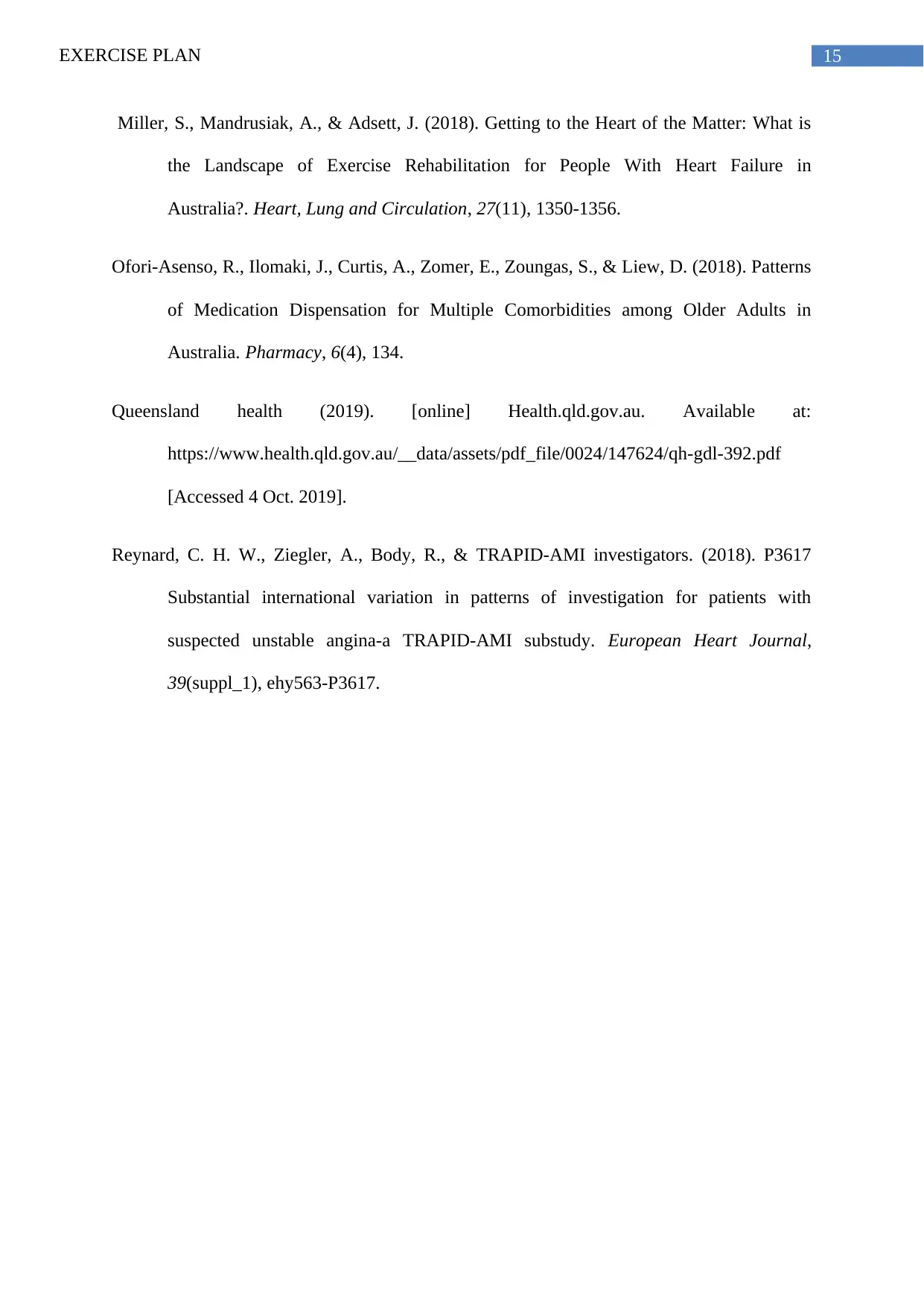
15EXERCISE PLAN
Miller, S., Mandrusiak, A., & Adsett, J. (2018). Getting to the Heart of the Matter: What is
the Landscape of Exercise Rehabilitation for People With Heart Failure in
Australia?. Heart, Lung and Circulation, 27(11), 1350-1356.
Ofori-Asenso, R., Ilomaki, J., Curtis, A., Zomer, E., Zoungas, S., & Liew, D. (2018). Patterns
of Medication Dispensation for Multiple Comorbidities among Older Adults in
Australia. Pharmacy, 6(4), 134.
Queensland health (2019). [online] Health.qld.gov.au. Available at:
https://www.health.qld.gov.au/__data/assets/pdf_file/0024/147624/qh-gdl-392.pdf
[Accessed 4 Oct. 2019].
Reynard, C. H. W., Ziegler, A., Body, R., & TRAPID-AMI investigators. (2018). P3617
Substantial international variation in patterns of investigation for patients with
suspected unstable angina-a TRAPID-AMI substudy. European Heart Journal,
39(suppl_1), ehy563-P3617.
Miller, S., Mandrusiak, A., & Adsett, J. (2018). Getting to the Heart of the Matter: What is
the Landscape of Exercise Rehabilitation for People With Heart Failure in
Australia?. Heart, Lung and Circulation, 27(11), 1350-1356.
Ofori-Asenso, R., Ilomaki, J., Curtis, A., Zomer, E., Zoungas, S., & Liew, D. (2018). Patterns
of Medication Dispensation for Multiple Comorbidities among Older Adults in
Australia. Pharmacy, 6(4), 134.
Queensland health (2019). [online] Health.qld.gov.au. Available at:
https://www.health.qld.gov.au/__data/assets/pdf_file/0024/147624/qh-gdl-392.pdf
[Accessed 4 Oct. 2019].
Reynard, C. H. W., Ziegler, A., Body, R., & TRAPID-AMI investigators. (2018). P3617
Substantial international variation in patterns of investigation for patients with
suspected unstable angina-a TRAPID-AMI substudy. European Heart Journal,
39(suppl_1), ehy563-P3617.
Secure Best Marks with AI Grader
Need help grading? Try our AI Grader for instant feedback on your assignments.
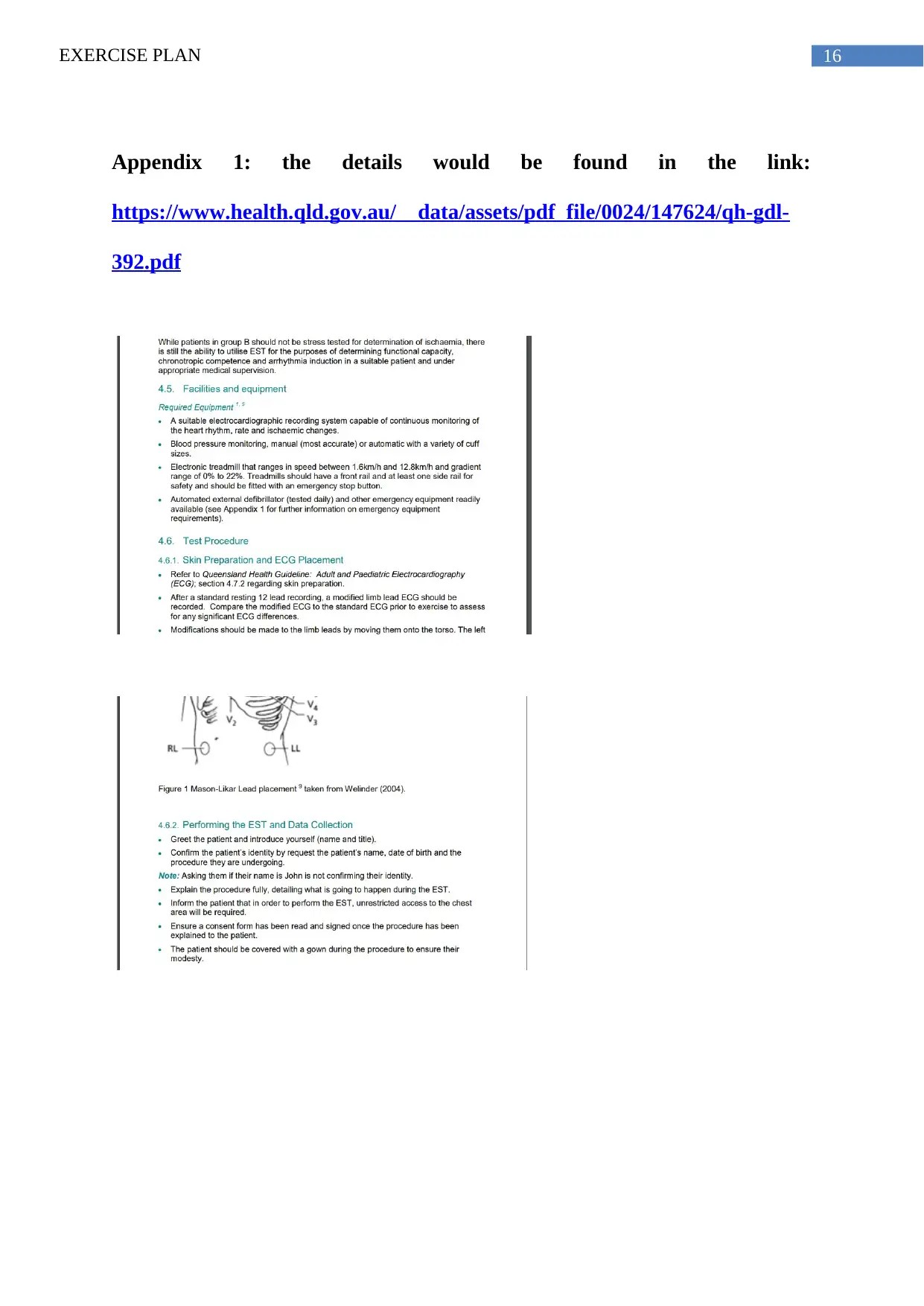
16EXERCISE PLAN
Appendix 1: the details would be found in the link:
https://www.health.qld.gov.au/__data/assets/pdf_file/0024/147624/qh-gdl-
392.pdf
Appendix 1: the details would be found in the link:
https://www.health.qld.gov.au/__data/assets/pdf_file/0024/147624/qh-gdl-
392.pdf
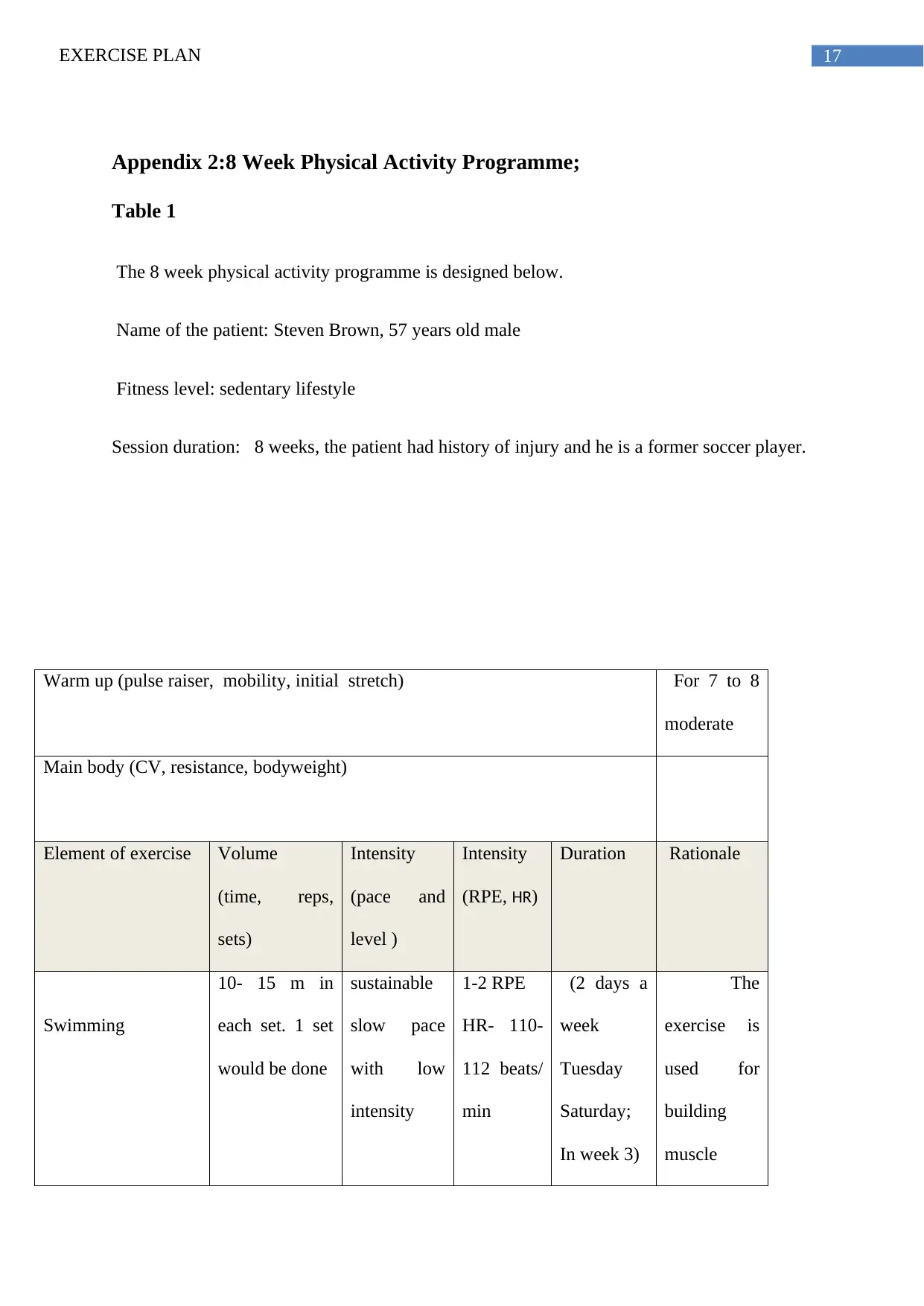
17EXERCISE PLAN
Appendix 2:8 Week Physical Activity Programme;
Table 1
The 8 week physical activity programme is designed below.
Name of the patient: Steven Brown, 57 years old male
Fitness level: sedentary lifestyle
Session duration: 8 weeks, the patient had history of injury and he is a former soccer player.
Warm up (pulse raiser, mobility, initial stretch) For 7 to 8
moderate
Main body (CV, resistance, bodyweight)
Element of exercise Volume
(time, reps,
sets)
Intensity
(pace and
level )
Intensity
(RPE, HR)
Duration Rationale
Swimming
10- 15 m in
each set. 1 set
would be done
sustainable
slow pace
with low
intensity
1-2 RPE
HR- 110-
112 beats/
min
(2 days a
week
Tuesday
Saturday;
In week 3)
The
exercise is
used for
building
muscle
Appendix 2:8 Week Physical Activity Programme;
Table 1
The 8 week physical activity programme is designed below.
Name of the patient: Steven Brown, 57 years old male
Fitness level: sedentary lifestyle
Session duration: 8 weeks, the patient had history of injury and he is a former soccer player.
Warm up (pulse raiser, mobility, initial stretch) For 7 to 8
moderate
Main body (CV, resistance, bodyweight)
Element of exercise Volume
(time, reps,
sets)
Intensity
(pace and
level )
Intensity
(RPE, HR)
Duration Rationale
Swimming
10- 15 m in
each set. 1 set
would be done
sustainable
slow pace
with low
intensity
1-2 RPE
HR- 110-
112 beats/
min
(2 days a
week
Tuesday
Saturday;
In week 3)
The
exercise is
used for
building
muscle
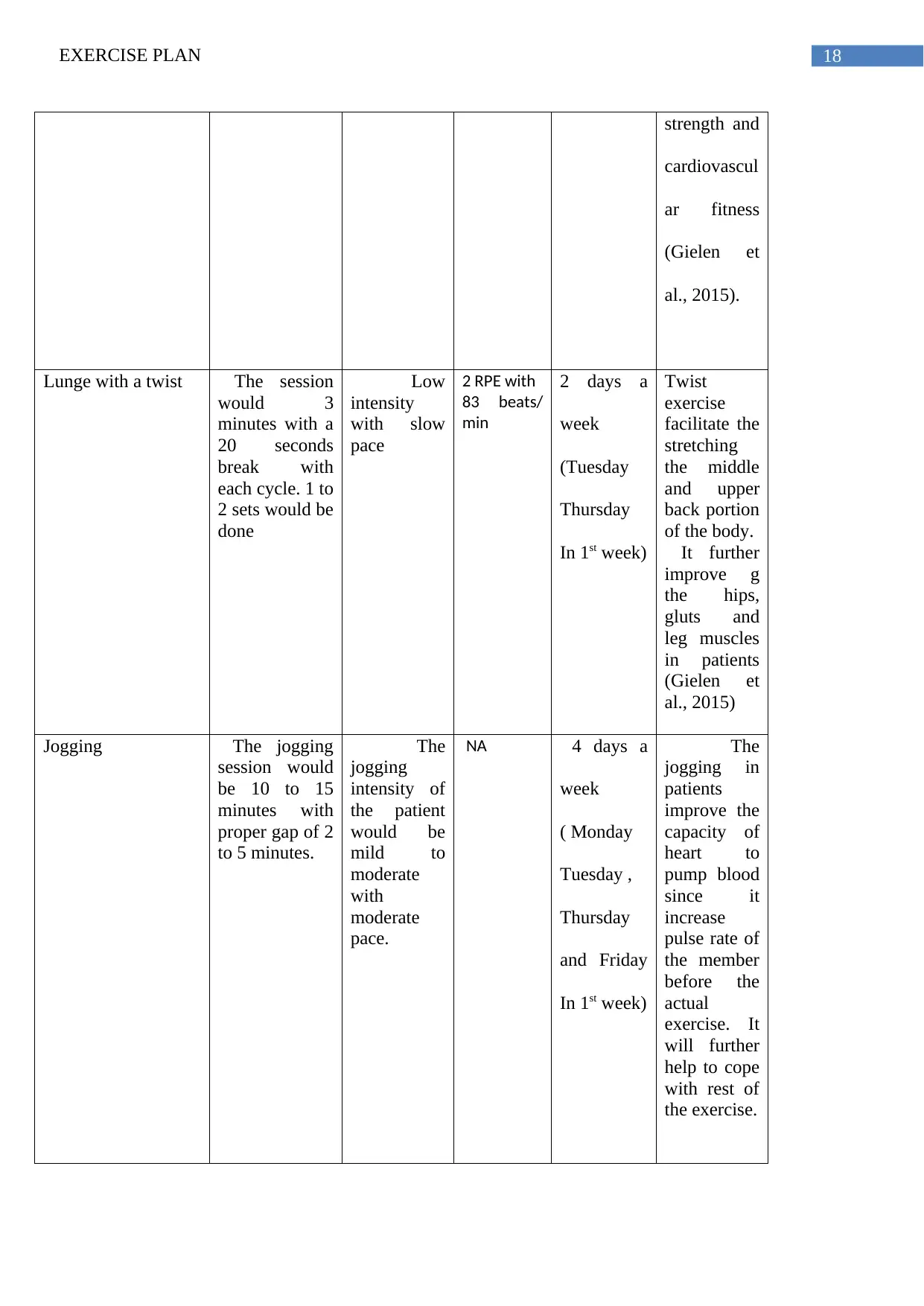
18EXERCISE PLAN
strength and
cardiovascul
ar fitness
(Gielen et
al., 2015).
Lunge with a twist The session
would 3
minutes with a
20 seconds
break with
each cycle. 1 to
2 sets would be
done
Low
intensity
with slow
pace
2 RPE with
83 beats/
min
2 days a
week
(Tuesday
Thursday
In 1st week)
Twist
exercise
facilitate the
stretching
the middle
and upper
back portion
of the body.
It further
improve g
the hips,
gluts and
leg muscles
in patients
(Gielen et
al., 2015)
Jogging The jogging
session would
be 10 to 15
minutes with
proper gap of 2
to 5 minutes.
The
jogging
intensity of
the patient
would be
mild to
moderate
with
moderate
pace.
NA 4 days a
week
( Monday
Tuesday ,
Thursday
and Friday
In 1st week)
The
jogging in
patients
improve the
capacity of
heart to
pump blood
since it
increase
pulse rate of
the member
before the
actual
exercise. It
will further
help to cope
with rest of
the exercise.
strength and
cardiovascul
ar fitness
(Gielen et
al., 2015).
Lunge with a twist The session
would 3
minutes with a
20 seconds
break with
each cycle. 1 to
2 sets would be
done
Low
intensity
with slow
pace
2 RPE with
83 beats/
min
2 days a
week
(Tuesday
Thursday
In 1st week)
Twist
exercise
facilitate the
stretching
the middle
and upper
back portion
of the body.
It further
improve g
the hips,
gluts and
leg muscles
in patients
(Gielen et
al., 2015)
Jogging The jogging
session would
be 10 to 15
minutes with
proper gap of 2
to 5 minutes.
The
jogging
intensity of
the patient
would be
mild to
moderate
with
moderate
pace.
NA 4 days a
week
( Monday
Tuesday ,
Thursday
and Friday
In 1st week)
The
jogging in
patients
improve the
capacity of
heart to
pump blood
since it
increase
pulse rate of
the member
before the
actual
exercise. It
will further
help to cope
with rest of
the exercise.
Paraphrase This Document
Need a fresh take? Get an instant paraphrase of this document with our AI Paraphraser
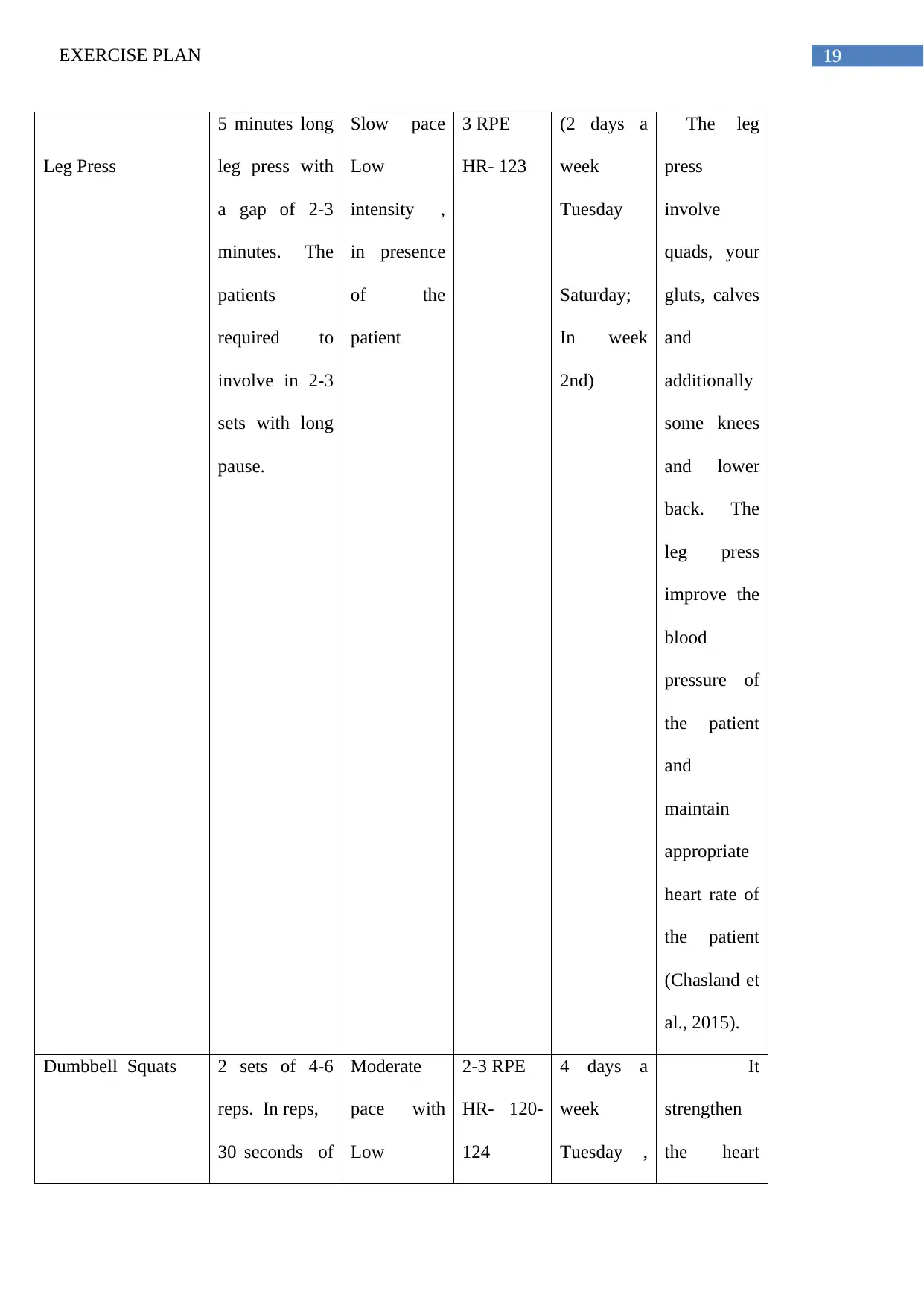
19EXERCISE PLAN
Leg Press
5 minutes long
leg press with
a gap of 2-3
minutes. The
patients
required to
involve in 2-3
sets with long
pause.
Slow pace
Low
intensity ,
in presence
of the
patient
3 RPE
HR- 123
(2 days a
week
Tuesday
Saturday;
In week
2nd)
The leg
press
involve
quads, your
gluts, calves
and
additionally
some knees
and lower
back. The
leg press
improve the
blood
pressure of
the patient
and
maintain
appropriate
heart rate of
the patient
(Chasland et
al., 2015).
Dumbbell Squats 2 sets of 4-6
reps. In reps,
30 seconds of
Moderate
pace with
Low
2-3 RPE
HR- 120-
124
4 days a
week
Tuesday ,
It
strengthen
the heart
Leg Press
5 minutes long
leg press with
a gap of 2-3
minutes. The
patients
required to
involve in 2-3
sets with long
pause.
Slow pace
Low
intensity ,
in presence
of the
patient
3 RPE
HR- 123
(2 days a
week
Tuesday
Saturday;
In week
2nd)
The leg
press
involve
quads, your
gluts, calves
and
additionally
some knees
and lower
back. The
leg press
improve the
blood
pressure of
the patient
and
maintain
appropriate
heart rate of
the patient
(Chasland et
al., 2015).
Dumbbell Squats 2 sets of 4-6
reps. In reps,
30 seconds of
Moderate
pace with
Low
2-3 RPE
HR- 120-
124
4 days a
week
Tuesday ,
It
strengthen
the heart
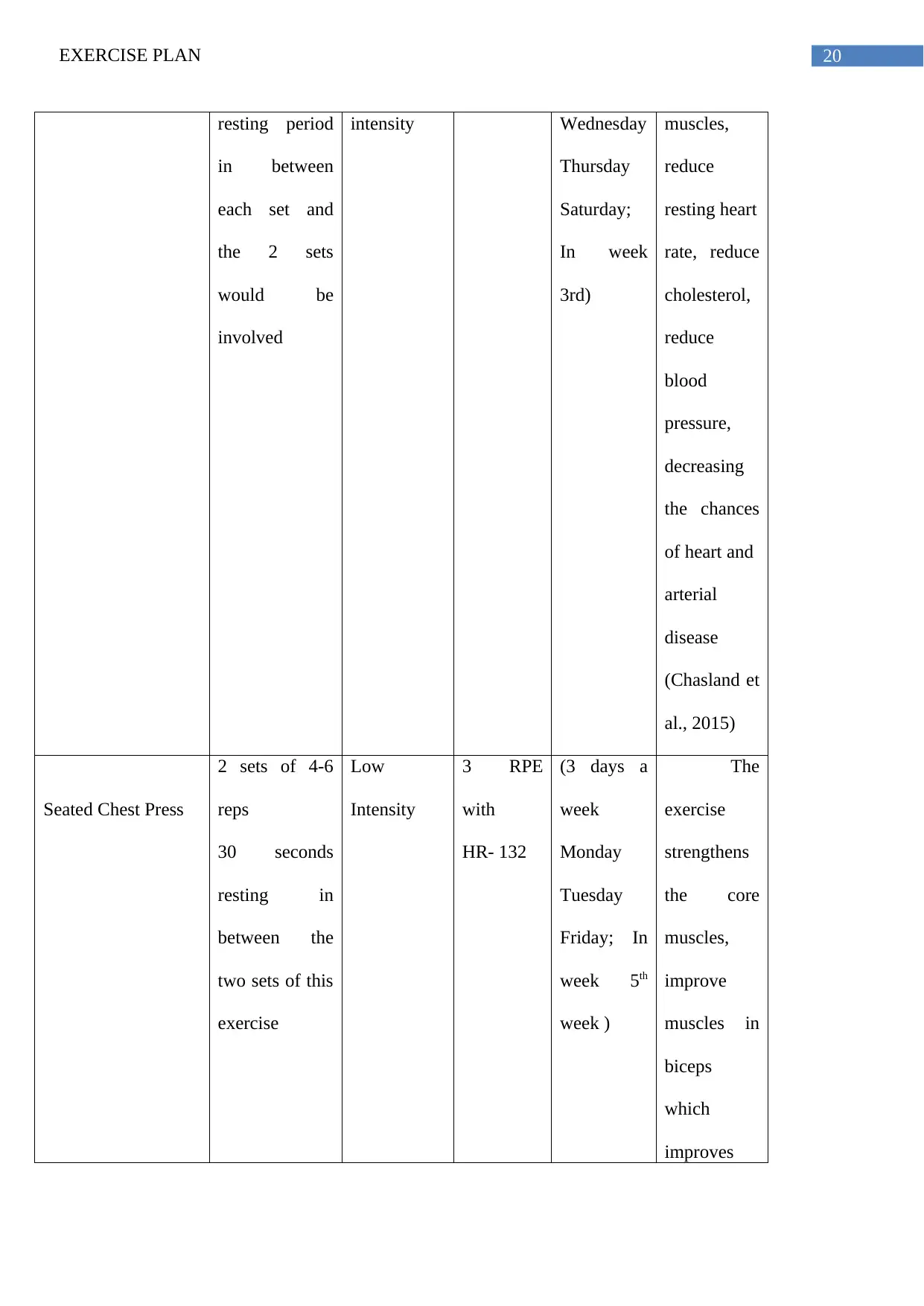
20EXERCISE PLAN
resting period
in between
each set and
the 2 sets
would be
involved
intensity Wednesday
Thursday
Saturday;
In week
3rd)
muscles,
reduce
resting heart
rate, reduce
cholesterol,
reduce
blood
pressure,
decreasing
the chances
of heart and
arterial
disease
(Chasland et
al., 2015)
Seated Chest Press
2 sets of 4-6
reps
30 seconds
resting in
between the
two sets of this
exercise
Low
Intensity
3 RPE
with
HR- 132
(3 days a
week
Monday
Tuesday
Friday; In
week 5th
week )
The
exercise
strengthens
the core
muscles,
improve
muscles in
biceps
which
improves
resting period
in between
each set and
the 2 sets
would be
involved
intensity Wednesday
Thursday
Saturday;
In week
3rd)
muscles,
reduce
resting heart
rate, reduce
cholesterol,
reduce
blood
pressure,
decreasing
the chances
of heart and
arterial
disease
(Chasland et
al., 2015)
Seated Chest Press
2 sets of 4-6
reps
30 seconds
resting in
between the
two sets of this
exercise
Low
Intensity
3 RPE
with
HR- 132
(3 days a
week
Monday
Tuesday
Friday; In
week 5th
week )
The
exercise
strengthens
the core
muscles,
improve
muscles in
biceps
which
improves
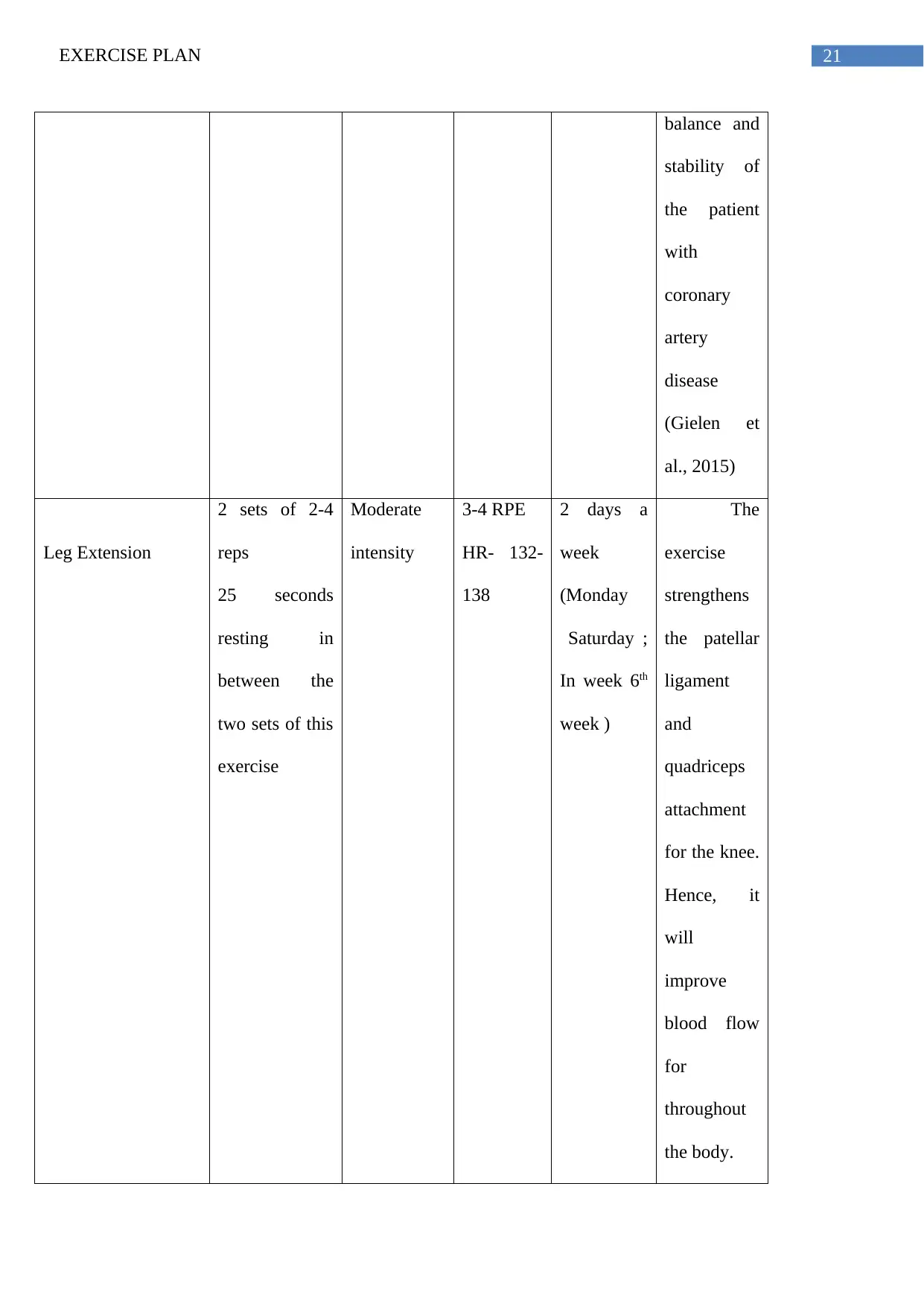
21EXERCISE PLAN
balance and
stability of
the patient
with
coronary
artery
disease
(Gielen et
al., 2015)
Leg Extension
2 sets of 2-4
reps
25 seconds
resting in
between the
two sets of this
exercise
Moderate
intensity
3-4 RPE
HR- 132-
138
2 days a
week
(Monday
Saturday ;
In week 6th
week )
The
exercise
strengthens
the patellar
ligament
and
quadriceps
attachment
for the knee.
Hence, it
will
improve
blood flow
for
throughout
the body.
balance and
stability of
the patient
with
coronary
artery
disease
(Gielen et
al., 2015)
Leg Extension
2 sets of 2-4
reps
25 seconds
resting in
between the
two sets of this
exercise
Moderate
intensity
3-4 RPE
HR- 132-
138
2 days a
week
(Monday
Saturday ;
In week 6th
week )
The
exercise
strengthens
the patellar
ligament
and
quadriceps
attachment
for the knee.
Hence, it
will
improve
blood flow
for
throughout
the body.
Secure Best Marks with AI Grader
Need help grading? Try our AI Grader for instant feedback on your assignments.
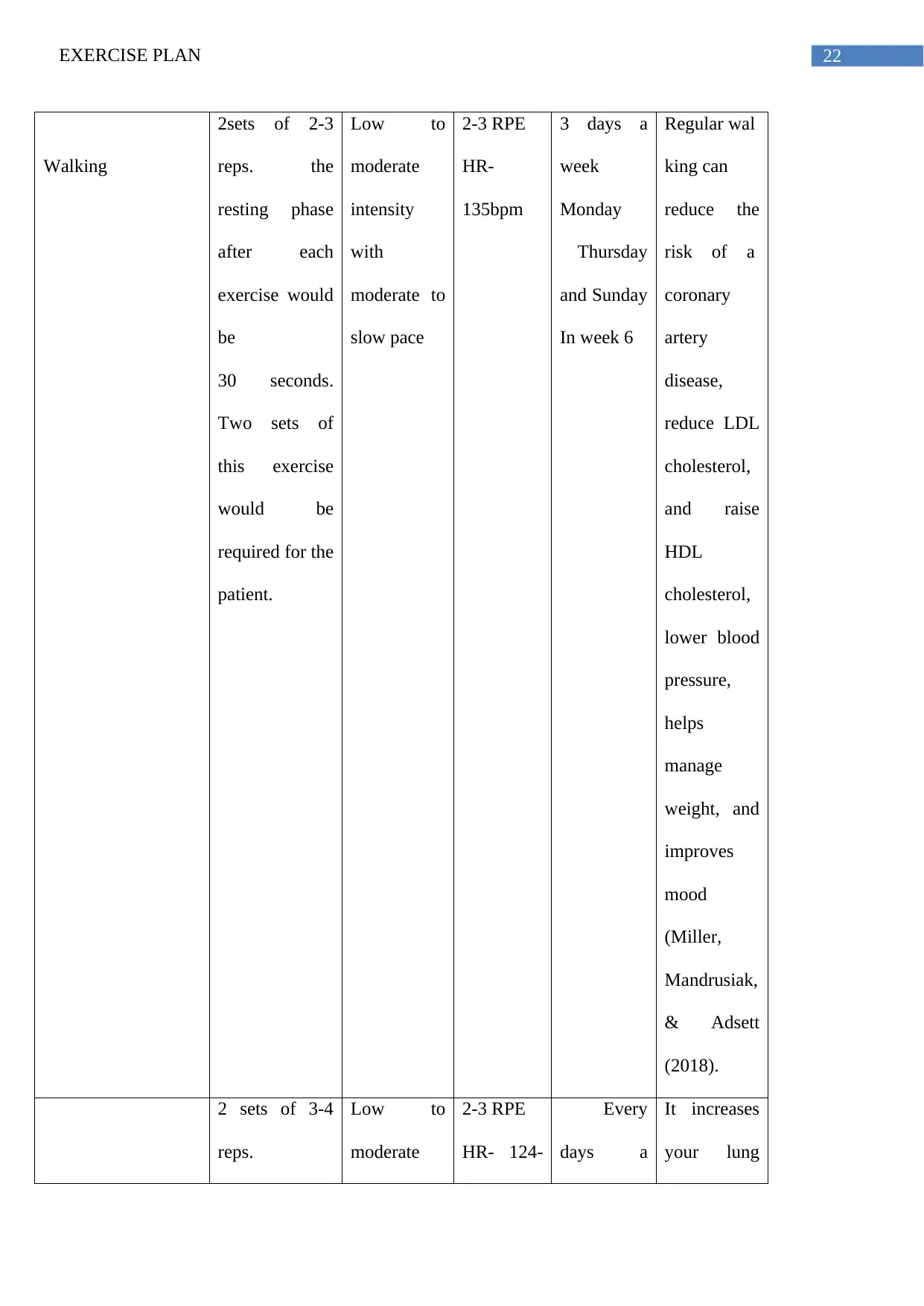
22EXERCISE PLAN
Walking
2sets of 2-3
reps. the
resting phase
after each
exercise would
be
30 seconds.
Two sets of
this exercise
would be
required for the
patient.
Low to
moderate
intensity
with
moderate to
slow pace
2-3 RPE
HR-
135bpm
3 days a
week
Monday
Thursday
and Sunday
In week 6
Regular wal
king can
reduce the
risk of a
coronary
artery
disease,
reduce LDL
cholesterol,
and raise
HDL
cholesterol,
lower blood
pressure,
helps
manage
weight, and
improves
mood
(Miller,
Mandrusiak,
& Adsett
(2018).
2 sets of 3-4
reps.
Low to
moderate
2-3 RPE
HR- 124-
Every
days a
It increases
your lung
Walking
2sets of 2-3
reps. the
resting phase
after each
exercise would
be
30 seconds.
Two sets of
this exercise
would be
required for the
patient.
Low to
moderate
intensity
with
moderate to
slow pace
2-3 RPE
HR-
135bpm
3 days a
week
Monday
Thursday
and Sunday
In week 6
Regular wal
king can
reduce the
risk of a
coronary
artery
disease,
reduce LDL
cholesterol,
and raise
HDL
cholesterol,
lower blood
pressure,
helps
manage
weight, and
improves
mood
(Miller,
Mandrusiak,
& Adsett
(2018).
2 sets of 3-4
reps.
Low to
moderate
2-3 RPE
HR- 124-
Every
days a
It increases
your lung
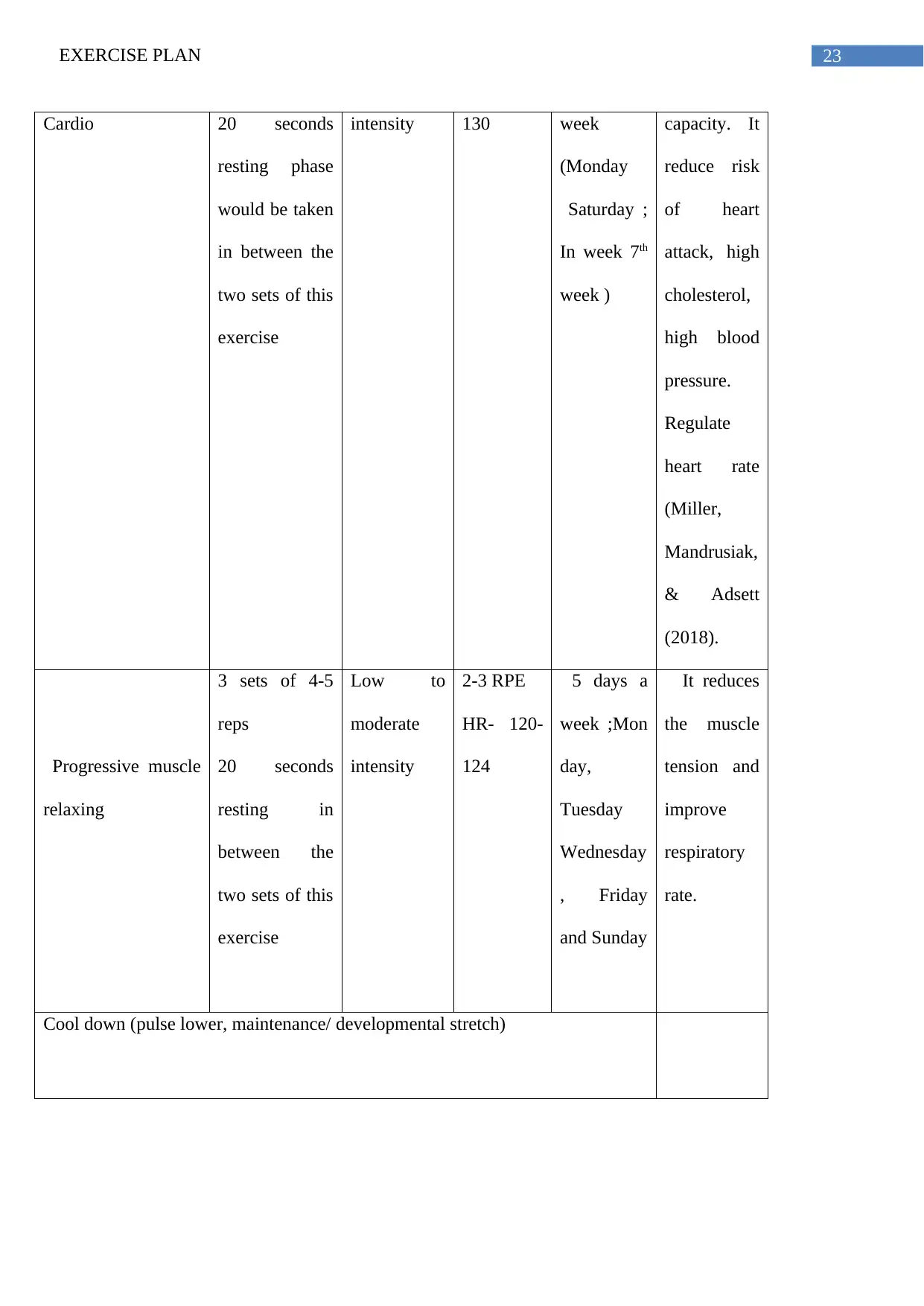
23EXERCISE PLAN
Cardio 20 seconds
resting phase
would be taken
in between the
two sets of this
exercise
intensity 130 week
(Monday
Saturday ;
In week 7th
week )
capacity. It
reduce risk
of heart
attack, high
cholesterol,
high blood
pressure.
Regulate
heart rate
(Miller,
Mandrusiak,
& Adsett
(2018).
Progressive muscle
relaxing
3 sets of 4-5
reps
20 seconds
resting in
between the
two sets of this
exercise
Low to
moderate
intensity
2-3 RPE
HR- 120-
124
5 days a
week ;Mon
day,
Tuesday
Wednesday
, Friday
and Sunday
It reduces
the muscle
tension and
improve
respiratory
rate.
Cool down (pulse lower, maintenance/ developmental stretch)
Cardio 20 seconds
resting phase
would be taken
in between the
two sets of this
exercise
intensity 130 week
(Monday
Saturday ;
In week 7th
week )
capacity. It
reduce risk
of heart
attack, high
cholesterol,
high blood
pressure.
Regulate
heart rate
(Miller,
Mandrusiak,
& Adsett
(2018).
Progressive muscle
relaxing
3 sets of 4-5
reps
20 seconds
resting in
between the
two sets of this
exercise
Low to
moderate
intensity
2-3 RPE
HR- 120-
124
5 days a
week ;Mon
day,
Tuesday
Wednesday
, Friday
and Sunday
It reduces
the muscle
tension and
improve
respiratory
rate.
Cool down (pulse lower, maintenance/ developmental stretch)

24EXERCISE PLAN
1 out of 25
Related Documents
Your All-in-One AI-Powered Toolkit for Academic Success.
+13062052269
info@desklib.com
Available 24*7 on WhatsApp / Email
![[object Object]](/_next/static/media/star-bottom.7253800d.svg)
Unlock your academic potential
© 2024 | Zucol Services PVT LTD | All rights reserved.





